Diane Wolfthal • Rice University
This article is dedicated to Rachel Dressler, whom I have known since she was a graduate student. We all owe her a great debt for her profound contribution to the field through her publications and her service, for example, her foresight in founding this journal.
Recommended citation: Diane Wolfthal, “Women Who Refuse to Mother: Complicating the Ideology of Motherhood in Northern European Art, 1400-1600,” Different Visions: New Perspectives on Medieval Art 8 (2022). https://doi.org/10.61302/IVOF4999.
In the Middle Ages, as today, the ideology of motherhood held sway, that is, the belief that women are naturally loving mothers who will protect their children at any cost.[1] Yet there were always some women who, upon giving birth, could not or would not care for their child. Then, as now, two options that were available to them were murder and abandonment. Sara McDougall recently stated that “pardons are almost all of what scholars of medieval France have to work with at present.”[2] This may be true of historians of law, but scholars in other fields may explore the numerous cultural productions that represent infanticide, such as songs, visual imagery, and mystery plays. This essay explores the murder and abandonment of unwanted children primarily through images that were produced in northern Europe in the fifteenth and sixteenth centuries. It begins by demonstrating the critical role that representations of men committing infanticide played in supporting the ideology of motherhood. Then it examines works that contradict or complicate this ideology: images that served in the execution of a woman convicted of killing her newborn, scenes of women killing their infants, and those that portray hospitals caring for foundlings. In doing so, this study asks two related questions: How did visual representations of infanticide reinforce or resist the ideology of motherhood? And how did images of infanticide and foundling hospitals represent or fail to represent women who refused to mother?
Male Infanticide and the Ideology of Motherhood
To most art historians, the word “infanticide” brings to mind images of the Massacre of the Innocents, which occurred when King Herod, fearing the birth of the future King of the Jews, ordered the slaughter of all boys two years old and younger who lived in and around Bethlehem. Although only one biblical verse describes this episode (Matthew 2:16), and the expanded account in the Golden Legend focuses on extraneous events in Herod’s life, the Massacre became an extremely popular subject in northern European art.[3] It appears in sculpture, panel painting, and the woodcuts that illustrate fifteenth-century printed editions of the Golden Legend and the Lives of the Saints.[4] But the Massacre of the Innocents was much more frequently portrayed in manuscripts, especially Books of Hours, where it became a standard theme for Compline and Vespers.[5] The subject was invoked for a variety of reasons: to show that it was part of a divine plan for human salvation, to depict the fulfillment of Jeremiah’s prophecy, as part of a series representing major scenes from the infancy of Christ, and even to protest the Spanish occupation of the Netherlands (as in Pieter Brueghel’s painting of 1565-67).[6] But the Massacre also functioned to support the ideology of motherhood.
Most depictions of the subject highlight heartbreaking scenes of grieving mothers. Filled with inconsolable women who try valiantly to save their children, such images reinforced the belief that mothers will do anything they can to protect their children. In a furious attempt to save their sons, they struggle with their assailants, pushing away the face of one and grabbing the lance of another (Fig. 1),
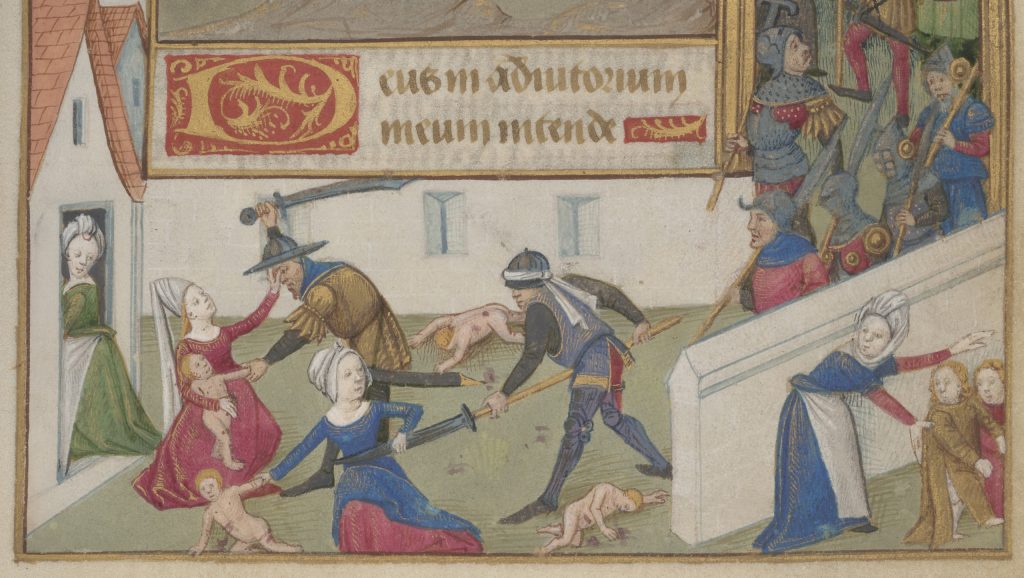
Figure 1. Poitiers, “Massacre of the Innocents,” Book of Hours, New York, Morgan Library & Museum, M. 1001, fol. 57r, ca. 1475 (detail). Purchased on the Fellows Fund, 1979.
pulling the arm of a third (Fig. 2),
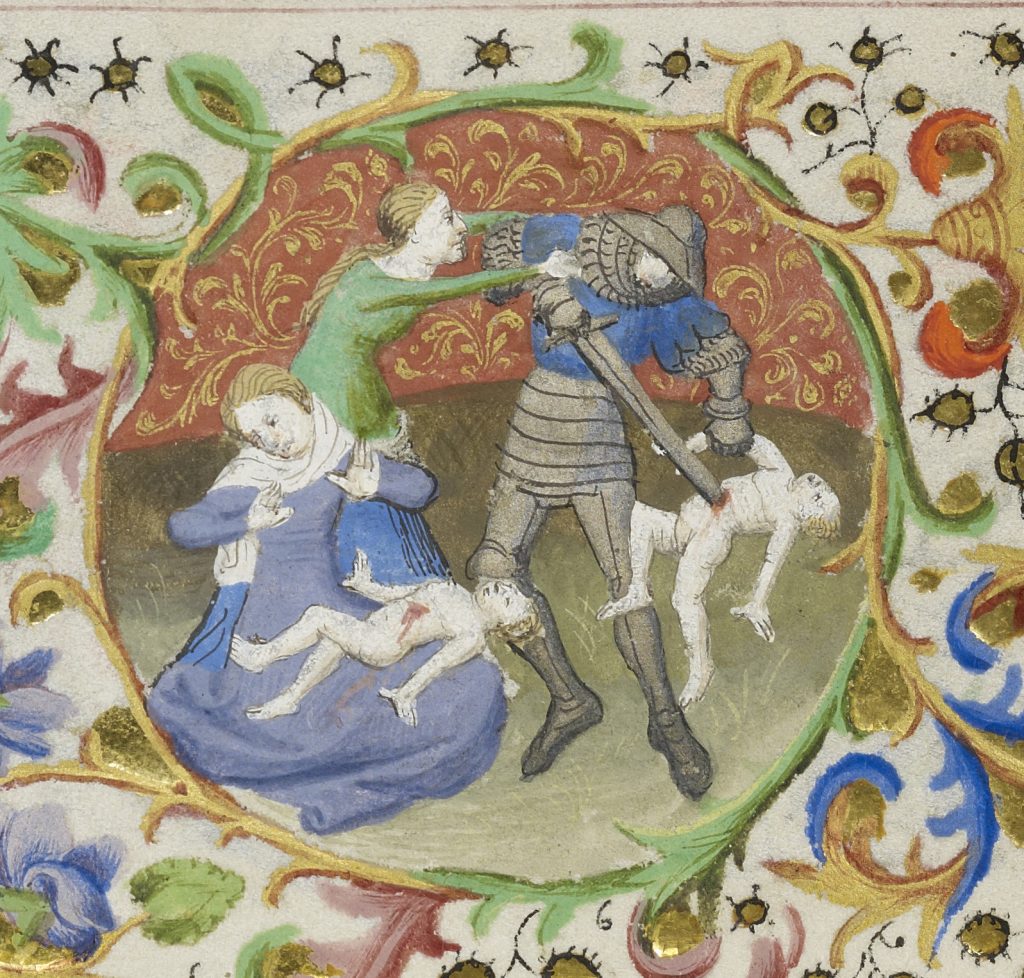
Figure 2. Paris, “Massacre of the Innocents,” Book of Hours, New York, Morgan Library & Museum, M. 453, fol. 83v (detail), ca. 1425-30. Purchased by J. Pierpont Morgan (1837-1913) in 1911.
and scratching the face of a fourth (Fig. 3).
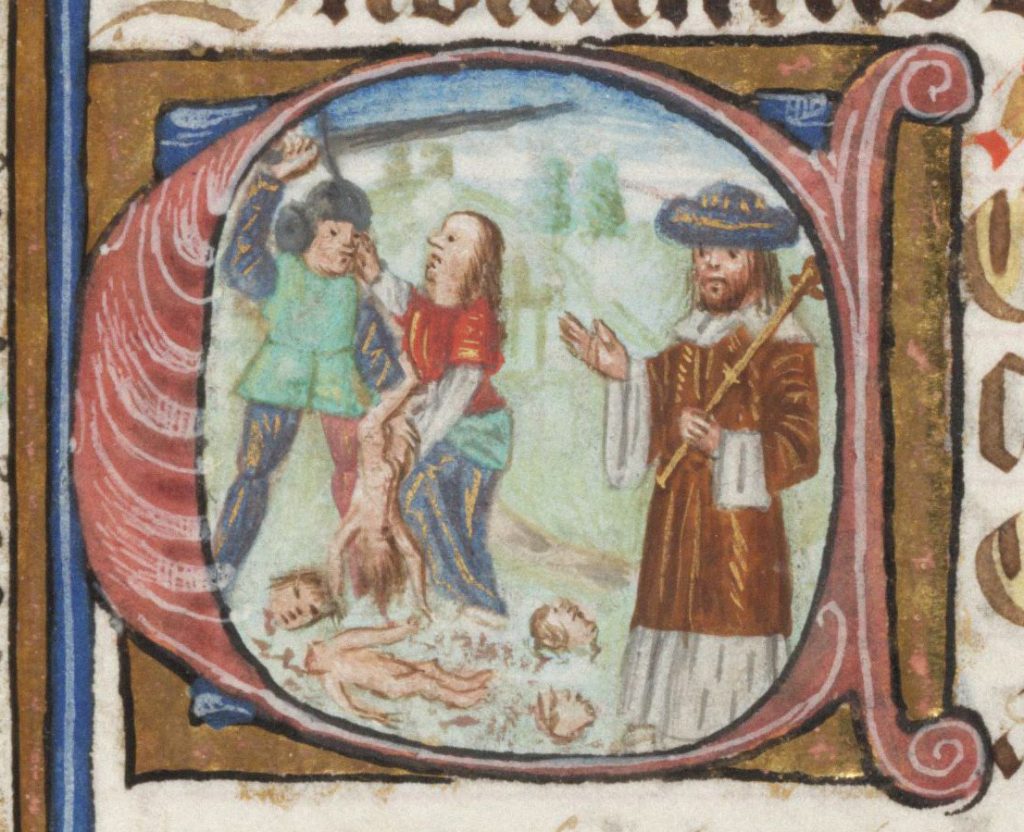
Figure 3. Flemish, “Massacre of the Innocents,” Book of Hours, Free Library of Philadelphia, Rare Book Department, Lewis E 104, fol. 57r (detail), 1450-75.
One mother directs a group of children towards an escape route (Fig. 1), while others beg for mercy or reveal their distress through their open mouth and puckered brow (Fig. 4).
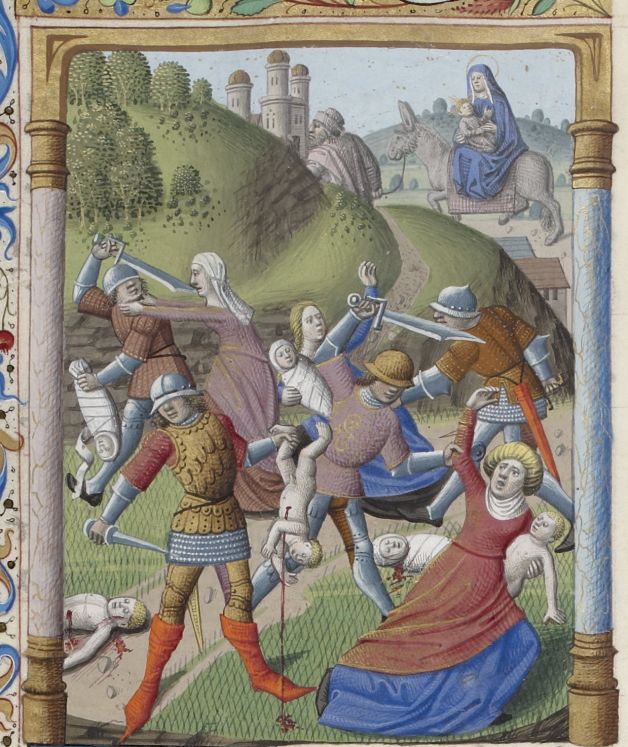
Figure 4. Jacques de Besançon. “Flight into Egypt and Massacre of the Innocents, Jacobus de Voragine, Golden Legend, Paris, BNF, Ms. fr. 244, fol. 27 bis v (detail), 1480-1490.
A typical illumination shows a woman fleeing, her swaddled infant clutched safely in her arm, as she threatens a soldier with her raised spindle (Fig. 5).
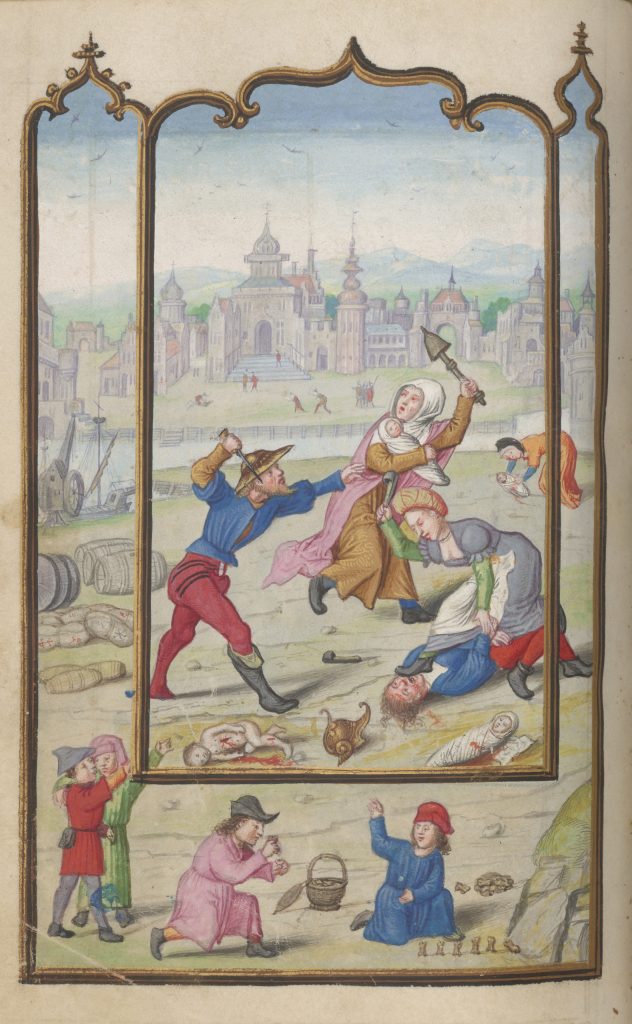
Figure 5. Bruges, “Massacre of the Innocents,” Book of Hours, New York, Morgan Library & Museum, M. 1175, fol. 77v, ca. 1525-30. Melvin R. Seiden Collection, 2011.
Nearby another mother immobilizes a soldier, straddling his body and bracing her shoe against his face so as to be better able to bludgeon his already-bloodied head with her club. Despite their feverish attempt to save their sons, the women’s efforts are futile. Bleeding bodies and severed heads and limbs lie scattered on the ground (Figs. 1, 3, 5). The mothers show the depths of their grief by throwing their arms out or gazing mutely at the dead child lying limply on their lap (Fig. 2).
Laura Jacobus has justly argued, concerning medieval Italy, that an ideology of motherhood flourished, which was bolstered by:
assertions and assumptions about the naturalness of maternal feeling. Traditional maternal practices which contradicted this assumption, such as abortion, infanticide, or child abandonment, were condemned. Conversely, breastfeeding was promoted from the pulpit through sermons and through visual images such as that of the nursing Madonna.[7]
The same holds true north of the Alps. Innumerable images of the Virgin and Child display the ideal loving mother. And a group of French illuminations pairs that subject with the Massacre of the Innocents, which further served to buttress the notion of the naturally loving and protective mother. An early thirteenth-century Psalter gives the two scenes equal billing, while a late fifteenth-century Golden Legend foregrounds the Massacre (Fig. 4).[8] At least nine French Books of Hours, dating 1425-1510, also juxtapose on the same folio the Madonna and Child on the Flight into Egypt and the slaughter of the innocent infants (Fig. 6-7).[9]
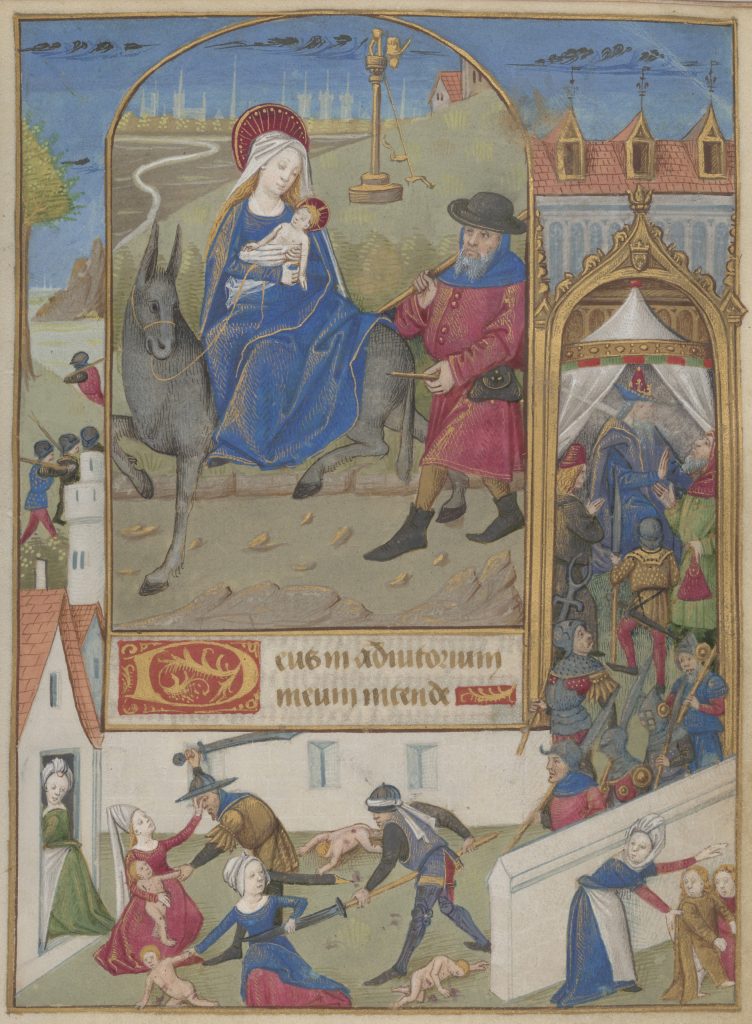
Figure 6. Poitiers, “Flight into Egypt and Massacre of the Innocents,” Book of Hours, New York, Morgan Library & Museum, M. 1001, fol. 57r, ca. 1475. Purchase on the Fellows Fund, 1979.
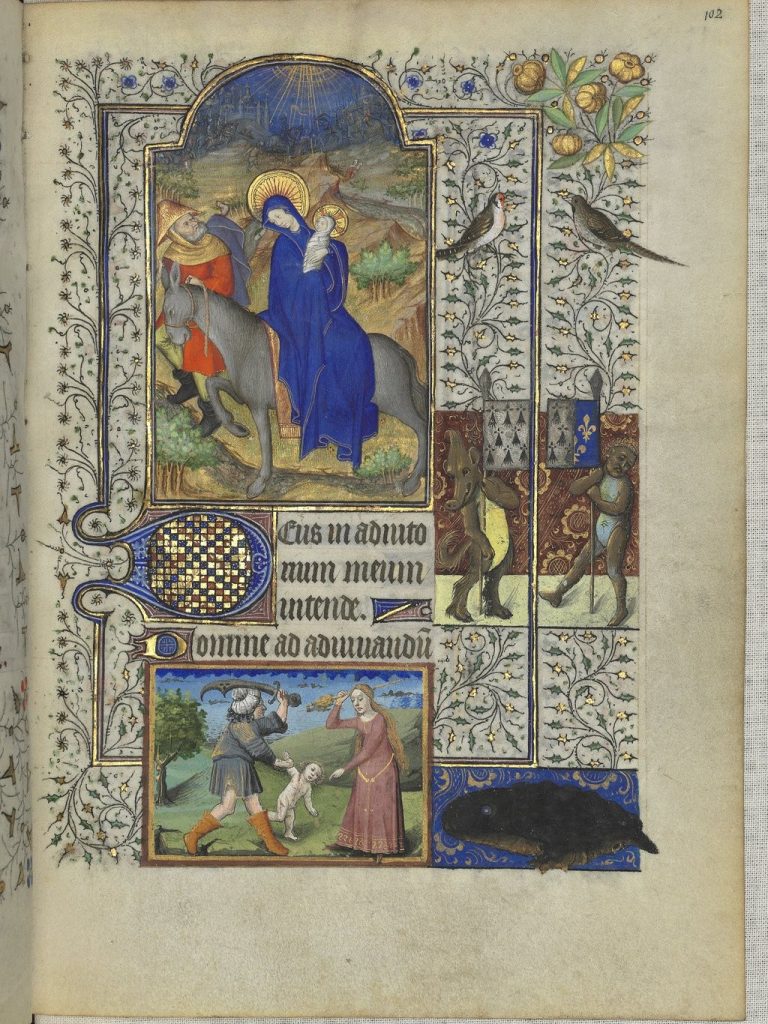
Figure 7. Renne (France), “Flight into Egypt and Massacre of the Innocents,” Hours of Marguerite d’Orléans, Paris, BNF, Latin 1156B, fol. 102, ca. 1445-50.
Although these two incidents are linked in the biblical narrative –the impending Massacre being the reason for the Flight – other moments in the story, for instance Herod’s command or the miraculous growth of wheat, could also have been highlighted. Instead, when the Flight and Massacre are paired, other episodes are eliminated or downplayed. In this way, this group of French illuminations links the two moments of the story that best support the ideology of motherhood: the loving Madonna who cradles the infant Christ in her embracing arms, generally shown above, and the heroic women who desperately, but unsuccessfully, try to save their children from a soldier’s sword, generally shown below. The two themes are also linked in a combination Book of Hours and Missal, produced in Ghent or Bruges in the late fifteenth century, which includes an illumination of pilgrims kneeling before a church portal.[10] Here the Massacre of the Innocents is shown in the central body of the text, and the loving Virgin nearby in the marginal portal. The two subjects continue to be joined in sixteenth-century panel paintings. For example, in the Master of Frankfurt’s Altarpiece of the Holy Kinship, dated ca. 1503-1506, the only two predella scenes show the Flight into Egypt and the Massacre of the Innocents.[11]
Art in the Service of an Execution
If most images exalt the ideal mother, others condemn her antithesis. In 1495, during an execution in Metz of a mother who was found guilty of committing infanticide, two works of art were employed: a wooden sculpture of the murdered child, and a painting on paper that represented the crime. Both are lost, like so many secular medieval works, but surviving texts describe them. The merchant Philippe de Vigneulle relates this particularly gruesome case, which occurred in his hometown. He recorded two versions of the event, one in his chronicle, the other in his memoir.[12] A servant, aged eighteen, became pregnant, concealed that fact from others, and gave birth when she was alone. She then killed her child by throwing it either on the floor (memoir) or against the wall (chronicle), and then hid the corpse in a well. When the body was discovered, she tried to hide it again, but was soon arrested, placed in a pillory, and fastened to a stake. Philippe’s chronicle then recounts:
And first, she had one of her hands cut off, and then the fire was lit and she was burned at the stake, but not so the fire would be allowed to consume her completely. Because, as soon as she was dead, they put out the fire, and she remained fully upright, and this was a hideous thing to behold. And they put a wooden child in her arms, along with a painting.”[13]
This ghastly punishment is rich in meaning; it was designed to serve as a lesson for the community. Esther Cohen, in her study of fifteenth-century criminology, notes that very few convicts were actually executed, but those who were received spectacular executions, which were attended by large crowds and accompanied by complex rituals. “Public executions,” she observes, “were secular rituals of communal meaning, carefully staged ceremonies conveying specific instructive messages to the public.”[14] Just as thieves’ hands were sometimes severed as the instruments of the crime, so the mother’s hand that killed her child was amputated. But it is notable that artwork – a sculpture and a painting – also played a major role in communicating the meaning of this execution. The woman who in life refused to accept motherhood was forced in death to cradle a wooden replacement for her infant in her arms. In this way she was compelled to fulfill the role of motherhood in public until the burnt husk of her body crumbled to dust.[15]
Philippe’s two accounts of the artworks vary slightly. The memoir is vaguer about the placement of the sculpture, but more detailed concerning the painting. It reports that as soon as “she was dead they put out the fire and her body was put on a wheel; and they put near her a little child of wood; and in addition to this another big paper, attached to the said wheel, on which there was a child painted and his mother who was killing him.”[16] Indeed wheels were sometimes employed to display criminals’ bodies or body parts.[17] Perhaps the paper was large so that the crowd below could more easily see it. A similar custom of depicting crimes was noted in antiquity. Quintilian, in his Institutio oratoria, writes of the practice of “bringing into court a picture of the crime painted on wood or canvas, that the judge might be stirred to fury by the horror of the sight.”[18] The large painting on paper of the mother murdering her own infant was probably similarly designed to arouse strong emotions against the killer. But it also, together with the wooden child, would have given voice to the mute victim of the crime, would have made present the infant who was absent. The mother’s voice, however, remained silent throughout the execution.
Objects were often displayed on or near a criminal to communicate the nature of the crime.[19] But the authorities probably also hoped that the statue and painting would enhance the deterrent effect of the execution. Especially the painting of a mother murdering her newborn might have made clear to the gathered crowd that this young woman was an unnaturally bad mother. Gazing at these art works would doubtless have brought to mind images that viewers would have known. If numerous beautiful works of art show the Madonna protectively and lovingly cradling her son in her arms, then this smoldering shell of a woman was her opposite: a murderous mother. If the visual culture repeatedly represented the mothers of Bethlehem fighting to save their sons’ lives, then the accompanying painting showed the reverse: a mother killing her child. By condemning the offender, the statue and the painting, like so many images of the Virgin and Child and the Massacre of the Innocents, were designed to support the ideal of the always loving mother. But by showing a murderous mother the painting also challenged the idea that women always protect their children. As Ulinka Rublack has justly concluded, “motherly aggression … went against the construction of good motherhood as a natural and stable female characteristic.”[20]
Reality, Ideology, and Representation in Images of Infanticide
Infanticide was a fact of life in the late Middle Ages. Although not commonly prosecuted in either religious or secular courts, it did occur. In the 1460s, Olivier Maillard, the celebrated Breton preacher, vividly evoked the horrors of infanticide when he noted that if one listened carefully, one could hear “from the bottom of latrines, ponds, and rivers, the wailing of the children who were thrown there.”[21] Although rarely recorded, infanticide does appear in a range of historical sources: letters requesting pardons, court records, law codes, memoirs, and chronicles. For this reason, historians have frequently discussed the nature of the crime.
Offenders came from all walks of life, but some were mothers. This should not be surprising since women, whether mothers or wet nurses, had the greatest access to infants, and therefore the greatest opportunity to harm them. Indeed fifteenth- and sixteenth- century German and Swiss law codes portray baby killers as female. The Basel Law of 1426 prescribes, “She shall be thrown in the Rhine,” a Tyrolean law of 1499 reads, “A woman who destroys her infant shall be buried alive in the earth and a stake impaled through her body,” and the Bamberg Law of 1507 cites the “woman who secretly and maliciously kills her infant.”[22] More specifically, northern European records indicate that some offenders, like the woman in Metz, were young servants who became pregnant out of wedlock and were vulnerable because they were alone, without the support of family or friends.[23]
The gender of the victim is rarely noted in historical documents, which suggests that this was not important to record keepers. Scholars disagree as to whether girls or boys were more often the victims of infanticide, but most conclude that illegitimate children of both sexes were targeted.[24] Smothering and drowning were the favored methods of committing infanticide.[25] In fact, suffocation was so common that confessional manuals advised priests to ask parents whether, when they were lying in bed, they took their child between them and smothered him.[26] Infant deaths due to smothering could be accidental, but a baby’s death was more apt to be judged intentional when it occurred in secret and attempts were made to conceal the victim’s body. For Philippe de Vigneulles, the fact that the mother had concealed her pregnancy, given birth alone, and hidden the corpse, suggested intentional homicide and therefore should be severely punished.[27] Some pardon letters and court records also describe the murderer committing the act alone and then hiding the corpse, and Martin Luther believed, “Women are mischievous and the maids too: they smother them [the infants] secretly.”[28]
Do visual representations of infanticide bear any resemblance to what we know of the historical reality? Although images of infanticide are quite varied, in the vast majority of cases both victim and offender are male. All the murderers and victims are male in the Massacre of the Innocents, which was by far the most common representation of infanticide. From Athamas to Saturn, fathers in ancient Greek and Roman myths not only kill their sons, but also sometimes eat them. Similarly, even in images purporting to illustrate medieval events, Jewish men were falsely depicted as the murderers of Simon of Trent, Muslim soldiers were maligned as vicious killers of innocent Christian boys, and Jewish men were depicted tossing a baby boy to his death to avoid forced conversion during the Third Crusade.[29] This raises another issue: baby killers are often marked as non-Europeans, or as Jews or Muslims. Even soldiers who murder children in the Massacre of the Innocents sometimes wear turbans or other orientalizing headgear (Fig. 7).
In short, late medieval images of infanticide that depict religious and mythological tales of fathers killing infants are far from mirrors of reality. This is not simply because they illustrate centuries-old tales, but also because they serve a contemporary ideological purpose. By showing only male victims, most images falsely suggest that boys are at greater risk from infanticide than girls. By envisioning assailants as from another time or place or as adherents of a different religion, some illuminations falsely reassured viewers that it was not their Christian neighbor who murdered infants. And by picturing baby killers as men, rather than women, most images served to sustain the ideology of motherhood, the image of the ideal, loving mother who fiercely protects her child.
Murderous Mothers from Classical Mythology
Of the small number of images that show women killing their children, almost all are ancient Greek or Roman legendary or mythological figures, such as the Amazons, the Cimbrians, and Medea.[30] Like scenes of fathers killing children, these women slay only their sons, which further supports the idea that boys are in greater danger than girls. And images of murderous mothers, like some of their male counterparts, are generally characters from ancient legends, faraway places, or different religions, which further removes the Christian viewer from the painful historical reality of infanticide. But unlike images of men committing infanticide, those showing women reveal cracks in the ideology of motherhood by suggesting that not all women protect their babies, and that, in fact, some murder their offspring.
The tale of the Cimbrians comes down to us in several versions. In the Histoire ancienne jusqu’à César, composed ca. 1208-13 for Roger, chastellan of Lille, once the Romans led by Gaius Marius had defeated the Cimbrian husbands, their wives tried to protect themselves by forming a circle of wagons and chariots and bravely fighting back with darts and arrows. When it became clear that they would lose to the Romans, they killed their children in a frenzy, and then committed suicide by slitting their own throats or hanging themselves from their wagons.[31] Similarly, Giovanni Boccaccio’s De mulieribus claris, written in 1361-62, relates that the wives of the “barbarian” Cimbrians tried to save their own chastity as well as their children’s freedom when the Roman general Gaius Marius conquered them. In Boccaccio’s version, they first “dashed their little children to the ground,” and then hung themselves.[32] Although Boccaccio characterizes their deed as “cruel,” he also praises them for killing their children to save them from slavery.[33]
This tale of infanticide is portrayed in quite a few northern European illuminations, and in every case in which the gender of the children is identifiable through haircuts or clothing, they are shown as boys. In a Parisian manuscript dated around 1402, a French translation of Boccaccio, three elegantly dressed women dangle gracefully from the branches of trees above their sons, who lie lifelessly on the ground (Fig. 8).[34]
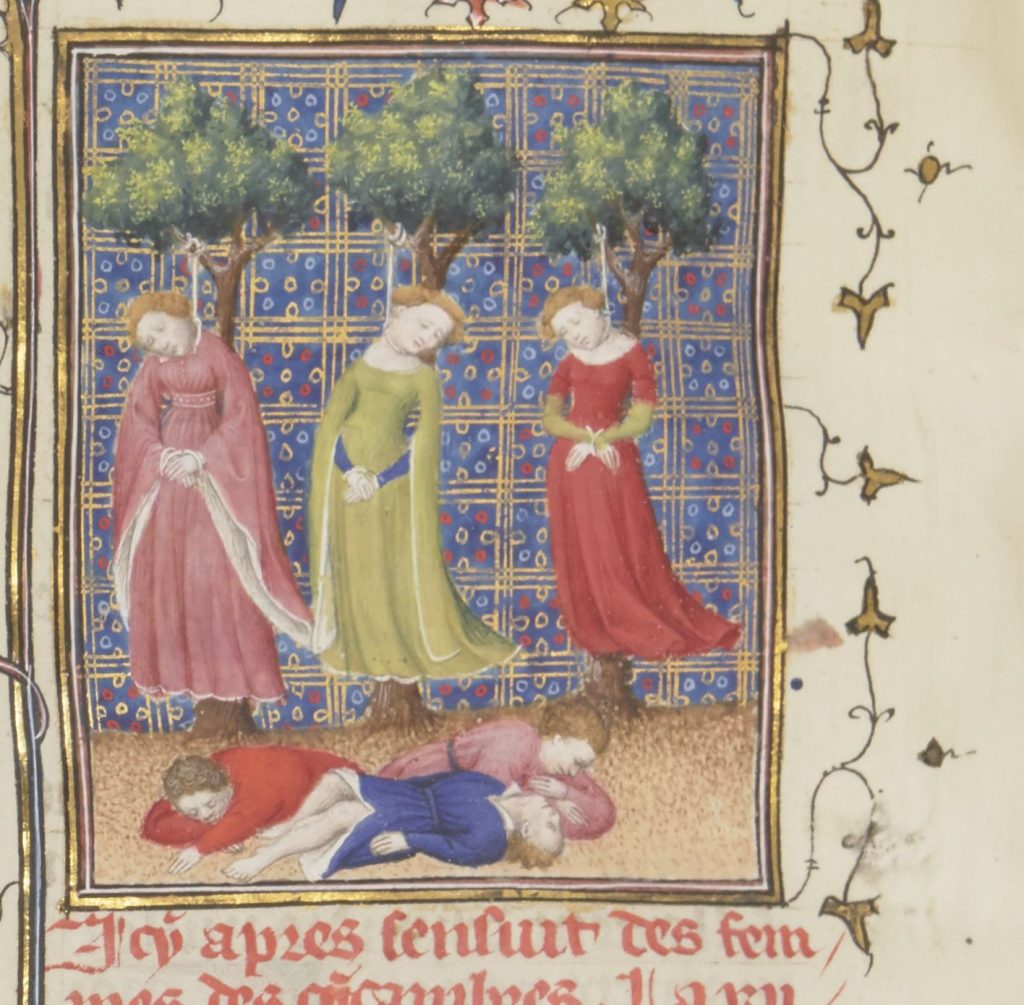
Figure 8. “The wives of the Cimbrians hang themselves after killing their children,” Boccaccio, Des cleres et nobles femmes, Paris, BNF, Fr. 12420, fol. 120v (detail).
In a German translation, published in Augsburg in 1479, the children are again boys, one clearly an infant.[35] And in a third version, published in Bern in 1539, the dead children, both babies and older boys, are scattered around a room (Fig. 9).[36]
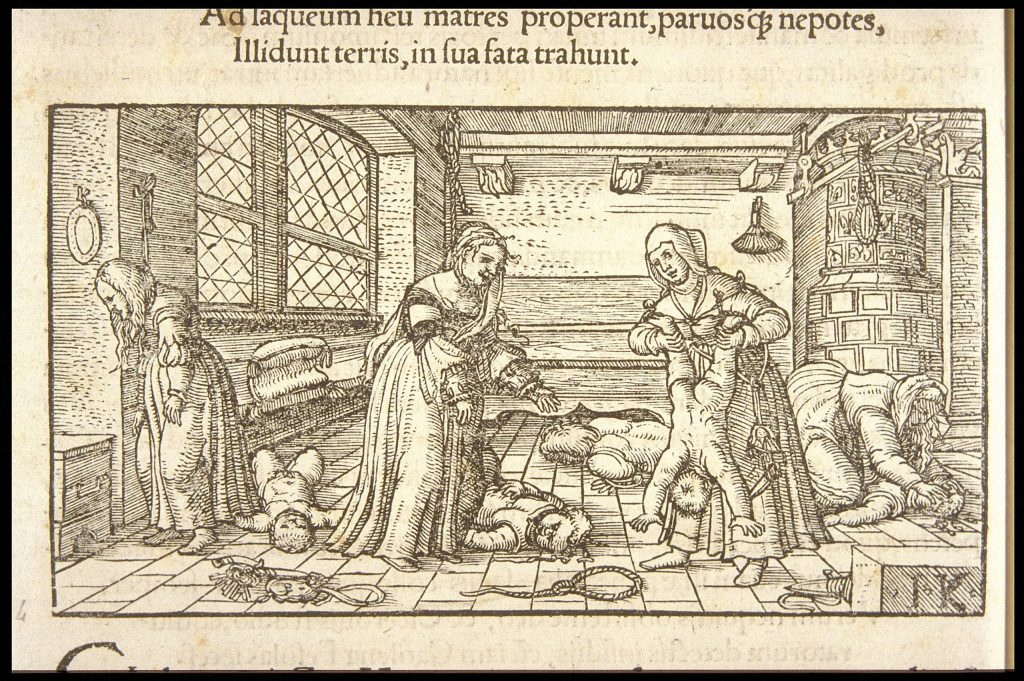
Figure 9. Jakob Kerver (artist), “The wives of the Cimbrians hang themselves after killing their children,” Boccaccio, De claris mulieribus (Bern: Mathias Apiarus 1539), Division of Rare and Manuscript Collections, Cornell University Library
The two women at the left are already hanging from the noose that circles their neck. To their right, a third mother is in the process of bashing her child’s head against the ground; her noose lies ready at center stage. A fourth mother, at the far right, bends vigorously over her son, her hand on his face, his limp body motionless on the floor. Her noose hangs on a beam just above her. Although the method of murder that is portrayed – dashing the babies’ heads on the ground – is attested to in contemporary pardon tales and in the chronicle of the execution at Metz, the Cimbrian wives are shown committing infanticide as a group, a practice not found in surviving historical documents.
Quite a few images show Medea, too, killing her sons, but for a very different reason. Medea fell in love with Jason and was instrumental in his successful quest for the Golden Fleece, but he ultimately abandoned her for another lover. In a fit of jealous rage, Medea murdered their sons, and this episode of their long and complicated tale is frequently illustrated in late medieval imagery. Scenes are varied, but rarely reflect the methods of infanticide that are commonly mentioned in trial records, pardon tales, and chronicles, such as suffocation or drowning. Nor do they portray the secrecy in which infanticide so often occurred. For example, in a late fifteenth-century English version of John Gower’s Confessio Amantis, Medea impales both sons with a single thrust of her huge sword, a weapon mentioned in some versions of this tale (Fig. 10).

Figure 10. England, perhaps London, “Medea Killing Her Sons,” in John Gower, Confessio Amantis, New York, Morgan Library & Museum, M. 126, fol. 108r (detail), ca. 1470. Purchased by J. Pierpont Morgan (1833-1913), 1903.
Committing infanticide by stabbing children with a sword is never mentioned in historical records and would be an unwieldy method for killing an infant. At the right, Jason threateningly grabs the hilt of his sword, while behind him a woman, who is probably his wife, raises her hand in horror. The artist emphasizes the ghastliness of the event by having Medea hold the tiny hands of her sons, by showing large quantities of bright red blood gushing from both boys’ wounds, and by showing the son closest to her already dead (judging by his closed eyes) so that, according to some texts, his brother will witness this death. It is noteworthy that Medea is not rendered wearing contemporary English dress, but rather exotic peacock-feathered wings and a turban-like headdress.
If Medea in the Gower manuscript seems incredibly calm and composed (Fig. 10), then other images of her communicate a very different emotional reaction. At least one suggests that Medea was deranged (Fig. 11), and contemporary documents voice the belief that madness sometimes leads to infanticide.
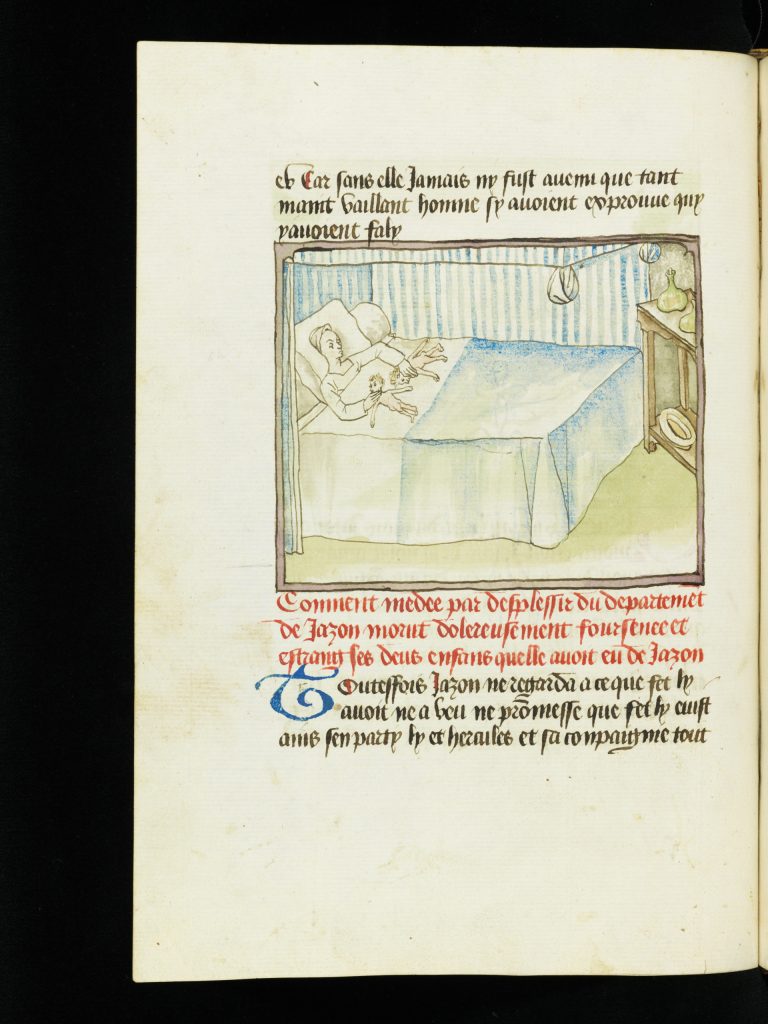
Figure 11. Lille, “Medea Strangling her Sons,” Histoire de Thèbes et de la destruction de Troie, Cologny, Fondation Martin Bodmer, Cod. Bodmer 160, fol. 73v (detail), 1469.
In 1379, according to a pardon letter, when Phote Brumel threw her daughter’s illegitimate child into a well, because she viewed it as a threat to an advantageous marriage, she became “mad” (hors du sens).[37] Similarly, when eighteen-year-old Michelle Galande, unwed and impoverished, buried her infant alive, it was partly due to her “simplicity and ignorance and the poverty and misery in which she lived.”[38] But she is also described as becoming “deprived then of sense and understanding” (“estoit lors de sens et entendment”).[39] Aleksandra Pfau concludes that those baby killers who plead insanity are not the poor, single women, but rather those whose cases would be viewed more negatively, those “more difficult to accept and integrate into a comprehendible narrative.”[40]
But an ink and wash drawing in a Histoire de Thèbes et Histoire de Troie, produced in Lille in 1469, suggests that Medea has become unhinged. It shows her lying in bed while strangling her children, a method of infanticide that is documented for fifteenth-century France and mentioned in the accompanying text (Fig. 11).[41] But it is not only the manner of killing, but also the emotional content of this illumination that rings true. The rubric reads, “How Medea, because she was displeased by the departure of Jason, killed in a fit of sorrow and madness, and strangled the two children that she had had with Jason.”[42] This crazed and depressed emotional state is effectively visualized through Medea’s downturned mouth and raised eyebrows (both typical of the illuminator’s style), her isolation in bed, the stillness of her form, her hands still circling the necks of her lifeless, tow-haired babies, and their nervous outlines. Underlining the tragedy of the event is the contrast between the dead children and the many womb-shaped forms that painfully suggest Medea’s potential for giving life: the curtain sacks above the bed and the two vessels on the table.[43]
Envisioning mothers who kill their infants as from another time and place must have falsely reassured viewers that it was not their Christian neighbors who killed innocent babies. But illuminations of the Cimbrians and Medea must have “fascinated, scandalised, and horrified medieval audiences,” as Hannah Morcos and Henry Ravenhall justly observe.[44] In showing murderous mothers in a way that strongly impacted viewers, such images reveal cracks in the ideology of motherhood.
Christine de Pizan’s Revision of Medea
For Christine de Pizan, the negative picture of Medea as a wicked and crazed baby killer was in desperate need of revision. A resistant female reader of misogynist texts and a writer who participated in the cultural production of the Valois courts, Christine, working within the discourse of classical myth, repeatedly challenged its negative portrayals of women.[45] An example of an image that she would have interpreted as negative is the illumination of the Cimbrians in the Parisian manuscript of ca. 1402 mentioned above (Fig. 8). Commissioned by a Parisian merchant for Philip the Bold, the Valois duke of Burgundy, it shows murderous mothers. In the Espistre Othea, written in 1399-1400, Christine revises this narrative in chapter 58, which focuses on Medea. The Othea was composed for a young prince, probably Louis, Duke of Orléans, and Christine supervised the production of three versions of her book. Two were lavishly illustrated, a version in Paris, BN Ms. 606, executed over the years 1407-1408, which was presented to Jean, Duke of Berry, and another in London, BL Harley 4431, which was presented to Queen Isabelle of France and dates a bit later, 1410-1411. Each chapter consists of four parts – the miniature, verse, gloss, and allegory – that independently interpret a single subject. In some respects, the images are the most important variation on the theme, since they would be more easily remembered than the many accompanying words.
Christine’s chapter never mentions Medea’s act of infanticide. The text warns that the prince should not permit his judgment to be “destroyed by illicit pleasure” (58. 2-3).[46] The gloss notes that Medea “let her judgment be destroyed by her desire” for Jason, yet it also describes her as “one of the wisest (plus savans) women of prophecy who ever lived.”[47] The subject of the image does not appear in the accompanying words at all, but rather is an independent interpretation of the story (Fig. 12).
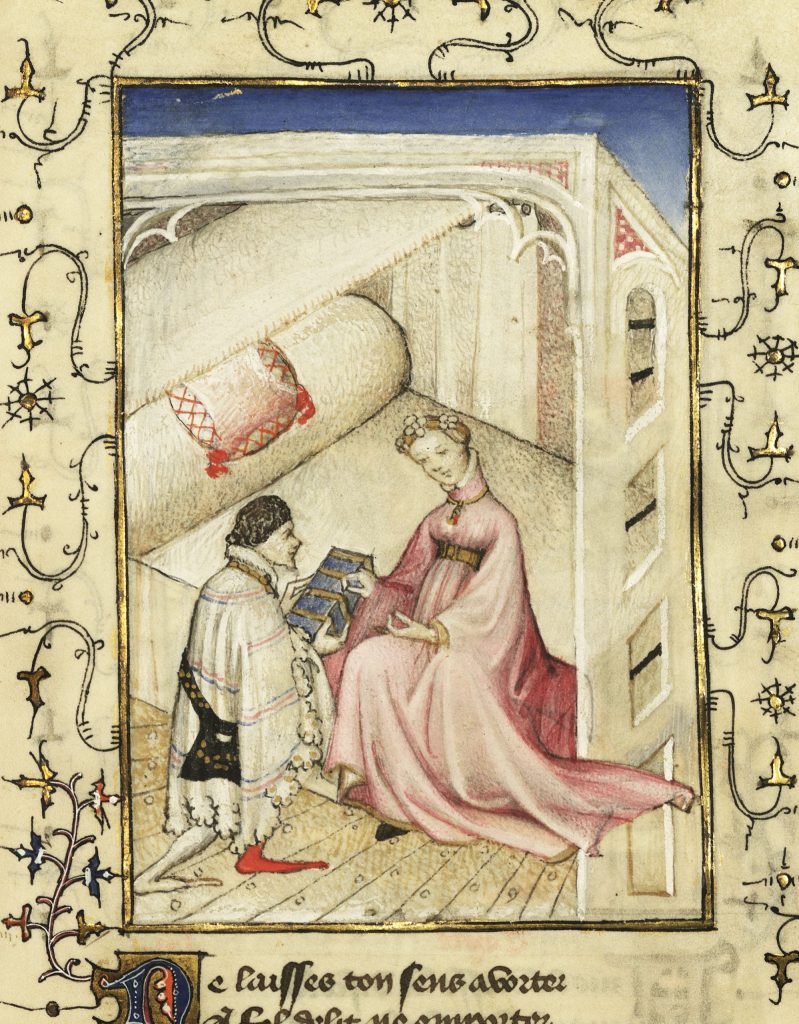
Figure 12. Christine de Pizan, “Medea Handing Jason a Coffer,” Epistre Othéa, Paris, BNF, Ms. 606, fol. 28r (detail), 1407-1409.
If numerous images of Medea show her killing her sons, then this deviates from that tradition by instead illustrating an earlier episode in the story, as Sandra Hindman has shown, when Medea helps Jason capture the Golden Fleece.[48] She asks him to come to her room, and then offers him two magical gifts, a ring and a charm. The miniature in Paris shows Medea sitting at the edge of her bed, and Jason kneeling before her. He holds a strongbox, which presumably contained the gifts, in both hands, while Medea opens its lock with one hand and fingers the ring in the other. Christine was intimately involved in the production of her texts, serving as the scribe and hiring illuminators. She must have instructed the illuminators to totally eliminate any reference to Medea as a crazed murderer in order to construct a more positive image of her. Instead, they portrayed the sorceress as calm and generous. By suppressing any reference to Medea’s act of infanticide, by excising this horrific event from her life, Christine totally sidesteps the idea of the woman who commits infanticide. In this way, she supports part of the ideology of motherhood: that women will not harm their infants.
Representations of Medieval Cases of Murderous Mothers
To my knowledge only two northern European images of the fifteenth and sixteenth centuries purport to represent actual medieval cases of murderous mothers. One appears in a manuscript produced in Dijon probably in the 1450s, which relates the history of the founding of the Hôpital Saint-Esprit in that town (Fig. 13).[49] (The manuscript will be discussed more fully below.)
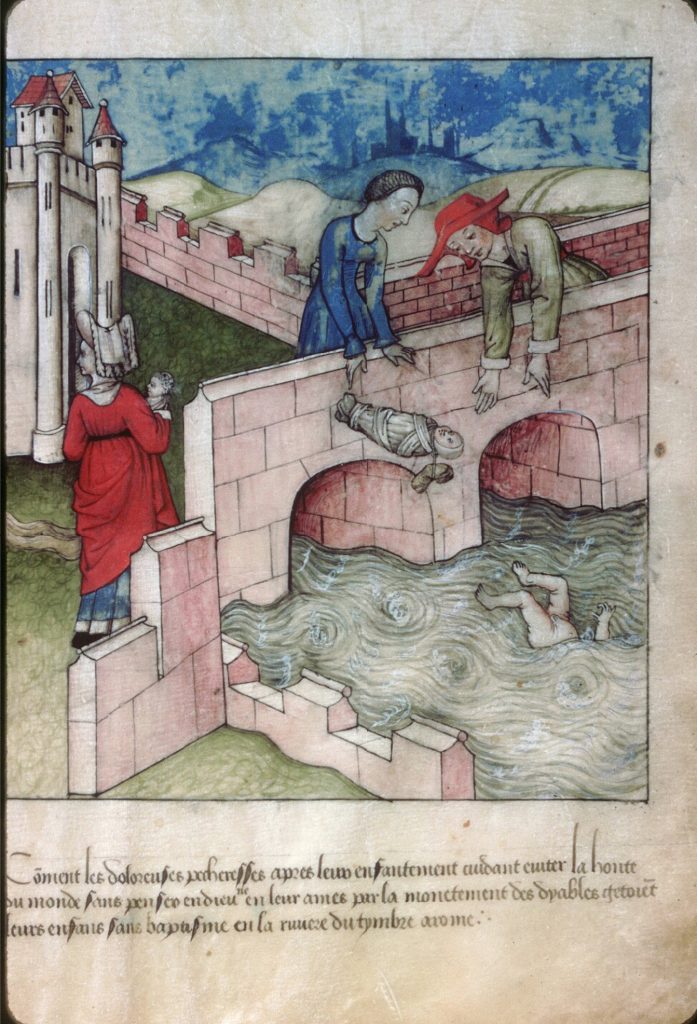
Figure 13. Dijon, “Florentine Mothers Drowning their Babies,” Dijon Archives hospitalières, Ms. A H 4, fol. 7, 1450s. Photo: IRHT/CNRS. By courtesy of the Dijon Bourgogne University Hospital.
The illumination, in watercolor on paper, shows infants dropped to their death off a bridge into the Tiber River. While one woman approaches at the left, her infant in her arms, another tosses into the river a swaddled baby with a weight tied around his neck. The third mother has already released her child, whose torso, arms, and head are submerged under water. His nudity reveals that he is a boy, which conforms to the usual practice of showing infanticide victims as male; this falsely suggests that they were in greater danger than girls. Here the murderers are the infants’ mothers (a fact confirmed by the caption), the method of murder is drowning, and the woman on the left turns her head, which suggests furtiveness, as if she wants to ensure that no one will witness her actions.[50] The image portrays two of the women as far from impoverished; the one on the left wears an elaborate headdress and multiple-layered garment.[51] Although the text relates that the incident had occurred in Florence centuries earlier, the architecture and costumes set the scene in fifteenth-century northern Europe. The reference to actual medieval acts of infanticide, so exceptional during the fifteenth and sixteenth centuries, stems from the function of the manuscript. Commissioned by the director of the hospital, this scene serves to justify the dire need for an institution that would care for foundlings.
The caption, written in French, reads, “How the sorrowful sinners after childbirth, trying to avoid the shame of the world, without thinking of God or their souls, by the urgings of the devils, throw their children without baptism into the Tiber River of Rome.”[52] These lines underscore a problem particular to Christian infanticide: unbaptized babies were believed to be condemned to hell. The inscription also suggests their mothers’ complex motivation.[53]
The caption is not the only source to suggest that shame and desperation were key factors that led to late-medieval infanticide. If a pregnant woman was poor, unmarried, and lacked the support of her family and community, her thoughts sometimes turned to infanticide – at least that is what some pardon letters suggest. For example, in 1393, Robine Poignant related that she had “tied her garters around the child’s throat and stopped its mouth and lay on top of him until he was dead,” because she was “totally desperate, fearing the vituperation of the world and the blame of her friends.”[54] Jeanne Pion declared in 1450 that her pregnancy caused her to feel “fear, doubt, and shame.”[55] When a noblewoman, the twenty-four-year-old Antonie van Claerhout, killed her newborn in 1453 she explained it this way: “fearing the anger and indignation of the said lord of Lichtervelde her uncle, and tempted by the enemy [the Devil], [she] took a knife and cut the throat of the said child.”[56] Her pardon letter repeats that she had “great fear that her act be known.”[57] In 1467, the chambermaid Colette Porcheron, pregnant with her master’s child, reported that she had said to her lover, “If I were pregnant, what would I do? I will be dishonored.”[58] In 1473, Jeanne Hardouyn, whose parents were too poor to afford a dowry, killed her newborn, “fearing the dishonor and shame of the world.”[59] Another mother confessed in 1474 that “fearing the shame of the world and the correction of her parents … [she] struck the child’s head upon the ground and hid it in the straw.”[60]
McDougall recently questioned whether women who killed their infants felt shame, arguing instead that women mentioned shame as a ploy to get a pardon.[61] But the constant repetition of shame as motivating infanticide, occurs not only in pardon tales, but also in captions for images, in law codes, and even in song lyrics. As late as 1624, an English law, which called for stricter punishment of infanticide, speaks of the desire of such women “to avoid shame.”[62]
Song lyrics also depict the ambivalence, shame, and fear that pardon tales and the illumination in Dijon attribute to some unwed mothers. As early as the thirteenth century, Latin lyrics that were translated into German imagine the reaction of a young, unmarried pregnant woman. One verse reads, “When I go outside, everybody looks at me as if I were some kind of monster. When they see my stomach they all nudge each other, and go quiet as I walk by. They’re always poking each other with their elbows, pointing their fingers at me, as if I had done something miraculous. They point me out with nods and judge me worthy of the pyre, because I once sinned.”[63]
The response is similar two centuries later in an Elizabethan bilingual carol, “Up Y arose in verno tempore (in springtime),” which purports to transcribe the private thoughts of a woman who is considering infanticide. Pregnant by a cleric, she is afraid to tell her parents or her lover, and tries to think through what to do about her dire situation. She laments that the pleasures of her past life are now gone, and she weeps because of her sin. She wonders what to say to her parents, and whether they will beat her with rods and sticks or reprimand her in front of others. In the concluding stanza she considers whether to keep the baby or kill it. If she slays it, she wonders where she should flee and whether she will “lose God and eternal life.”[64] In the song, she never resolves her dilemma. Each line begins in English and ends in Latin, perhaps to suggest her divided voice. This lyric appears in the well-known Ritson’s manuscript, a late fifteenth-century collection of secular and sacred music that was sung by a choir of boys and men in the West Country of England, probably in the area of Exeter. Linda Austern, who has brilliantly analyzed this carol, assumes that the audience for such a song, included “young girls, seminarians lacking the proper temperament for their vocation, mothers responsible for daughters’ moral education, writers of sermons, or any and all human beings who must make choices that affect their immortal souls.”[65] The lyrics of both songs explore some of the issues that medieval society believed unmarried, pregnant women faced, and neither resolves with easy moral judgments the tragic situation in which such women found themselves.
This is certainly not true for the second image that purports to represent a contemporary case: a moralistic, judgmental woodcut that served as a frontispiece to an account of a gruesome crime committed in 1551. Written by the Lutheran minister Burckhard Waldis, it relates the case of a mother who murdered her four young children and then herself at Weidenhausen in Hesse (Fig. 14).[66]
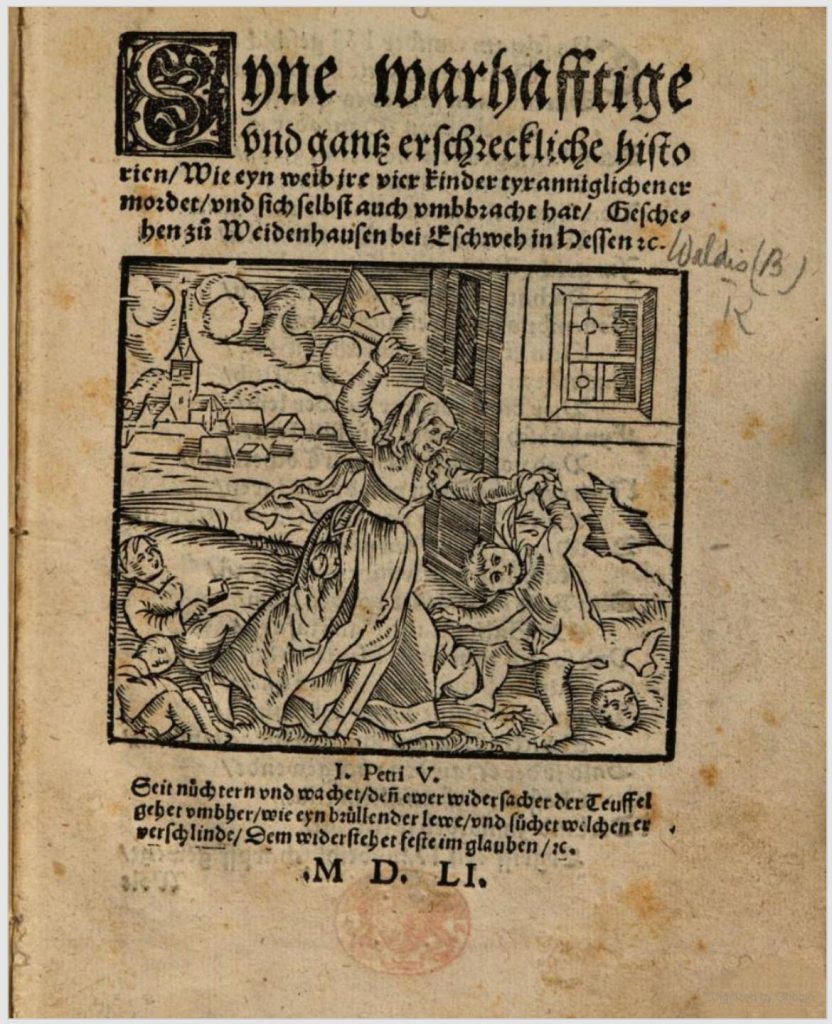
Figure 14. Frontispiece, Burkard Waldis, Eyne warhafftige … historien/ Wie eyn weib jre vier kinder … ermordet/ und sich selbst auch umbbracht hat (Marburg: 1551). London, British Library.
Waldis makes clear his belief that the Devil made her do it and imagines the children begging their mother for mercy. One cries, “O dearest mother mine, spare me, I’ll do whate’er thou’lt say” (hertz liebste mutter mein/ Vershon mein doch vnd laß dir sagen).[67] After killing her children, Waldis reports, the mother committed suicide, but before dying, she repented and converted. The accompanying image shows the woman raising an ax above a boy whom she holds by the hand. Remains of other children – all boys – lie scattered across the foreground. No Devil is depicted, but a church in the background gestures towards the woman’s conversion and the Lutheran message of redemption. Joy Wiltenburg notes that crime broadsheets rarely delve into the internal motives of the murderer. Indeed, here the woman’s problem appears to be external. Just as the caption for the illumination of women throwing their babies into the Tiber asserts that the Devil instigated the crime (Fig. 13), so, here, too, Waldis asserts the Devil made the mother murder her four children, “The Devil did her will maintain” (Ihrn willen schafft des Teuffels kunst).[68] Earlier texts and images had also blamed the Devil for infanticide. For example, in an illumination in a manuscript of Gautier de Coincy’s Miracles de Notre-Dame, commissioned in 1327 by King Charles IV of France, it is the Devil, not the mother, who throws the infant out the window, before it is saved by the Virgin.[69] Similarly, pardon tales relate that mothers were “tempted by the enemy,” that is, Satan.[70]
Anger as a Motive for Infanticide
If the Cimbrians’ wished to avoid enslaving their sons (Figs. 8-9), then revenge is the driving force for most murdering mothers in medieval literature, including Medea (Figs. 10-11).[71] But neither fear of enslavement nor revenge figure in contemporary historical records. By contrast, as we have seen, the words accompanying the two images of contemporary acts of female infanticide attribute the act to the Devil or to the mothers’ desire to avoid feeling shame, ideas often echoed in contemporary historical documents (Figs. 13-14). As Natalie Zemon Davis has made clear, however, women seeking a pardon tended to avoid stating that anger motivated their crime.[72]
But one image of female infanticide makes clear that it is a consequence of wrath, a pen-and-wash drawing, produced around 1545 by Luca Penni, a Florentine-born immigrant to France (Fig. 15).

Figure 15. Léon Davent after Luca Penni, “The Sin of Wrath and its Fruits” from Les sept péchés capitaux (present location unknown)
This composition was reproduced in an etching by Léon Davent several years later, as part of a series devoted to the seven deadly sins.[73] The rage that accompanies war is portrayed in the central oval with an episode from Flavius Josephus’ Jewish War that occurred following the siege and destruction of Jerusalem. Set against a burning city, it shows Titus ordering the execution of two Jewish elders in the year 70. At the upper left is another result of anger: a woman grabs a child’s arm to steady him so that she may kill him with a dagger. At least one other infant lies dead on the ground, his severed limb visible underneath the table. Like most scenes of female assailants, the offender is not clothed in contemporary garments, but rather in vaguely classicizing drapery. Kathleen Wilson-Chevalier identifies her as either Medea or the Jewish noblewoman, who, during the siege of Jerusalem, killed and ingested her son in order to save him from slavery and herself from hunger.[74] The rondel at the upper right shows a similarly dressed woman, who may be the same woman. This more decorously clad figure adds children’s body parts to a boiling cauldron. Cannibalism appears with increasing frequency in sixteenth-century images in chronicles, travel books, witches’ manuals, and even allegorical prints of Famine.[75] Perhaps it was invoked here, at least in part, to suggest that infanticide is a horrifying, monstrous act.
An Alternative Path
Gradually some medieval cities developed an alternative to infanticide; hospitals were created that would accept infants and young children who were abandoned by their natal family. The best known were established by the Order of the Holy Spirit, which was sparked by Guy de Montpellier’s foundation, around 1180, of a lay community in Provence that was dedicated to the Holy Ghost and cared for the sick.[76] Pope Innocent III (d. 1216), who had studied in Paris where he had been exposed to French ideas about charity, officially started the Order when he founded the Hospital of Santo Spirito in Rome. In turn, Odo III (d. 1218), Duke of Burgundy, came under the Pope’s influence, and built a hospital in Dijon under the auspices of the Order.[77]
A series of twenty-two large illuminations with brief captions, which were produced in Dijon between 1450 and 1467, narrates the story of the establishment of the hospitals in Rome and Dijon by Innocent and Odo. Always housed in the hospital there, the images were almost certainly commissioned by Pierre Crapillet, rector of the Dijon hospital, to support his desire to declare his institution’s independence from the guardianship of the hospital in Besançon and instead be directly supervised by Santo Spirito in Rome. The illuminations bolster Crapillet’s claim that the founding of the hospital in Dijon was a direct result of the establishment of Santo Spirito, and that, moreover, its establishment depended on miraculous intervention.
The series first presents the problem – infanticide – and then offers the solution: the care of abandoned children in hospitals. Others have discussed the entire codex, but here my focus will be on those images that include the infants or their mothers. The scene of infanticide, the third in the series, was discussed above (Fig. 13). In the folio after the scene of infanticide an angel advises the sick pope to send fisherman to the Tiber so that their fish will heal him. The sixth illumination depicts fishermen collecting grey, lifeless babies in their net, while above one holds a pink, plump living infant in his arms (Fig. 16).
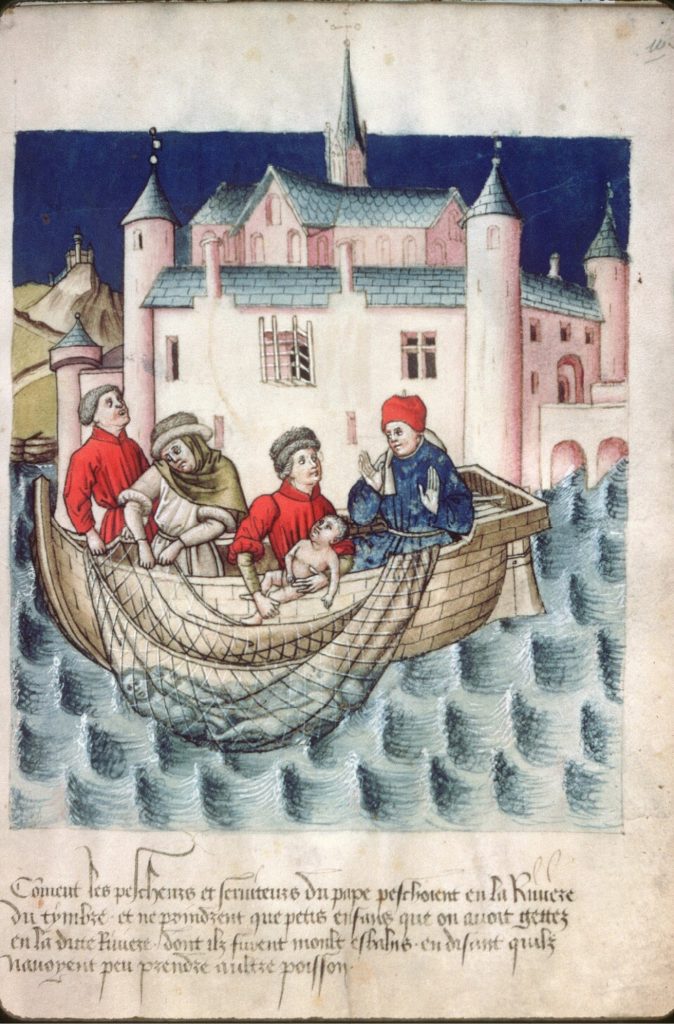
Figure 16. Dijon, “Fishing Infant Corpses from the Tiber River,” Dijon Archives hospitalières, Ms. A H 4, fol. 10, 1450s. Photo: IRHT/CNRS. By courtesy of the Dijon Bourgogne University Hospital.
The caption notes that the fishermen were astonished, since they had caught no fish, but only babies who had been thrown into the river.[78] Next the fishermen present their catch to the pope, who gestures his astonishment. After a visit by an angel, the pope decides to establish a hospital “to receive all the poor and to nourish all the small children who have been thrown away.”[79] Several more images tell the story of the founding of Santo Spirito before the plot shifts to the duke of Burgundy.
During a dangerous storm at sea, Odo promises God that if he is saved, he will build a chapel in Dijon. When the duke arrives in Rome, the pope offers him a tour of his hospital, which cares, among others, for “all the poor cast-off orphans” (tous povres orphelins getons), two of whom sit on the floor, one with his arm around the other (Fig. 17).
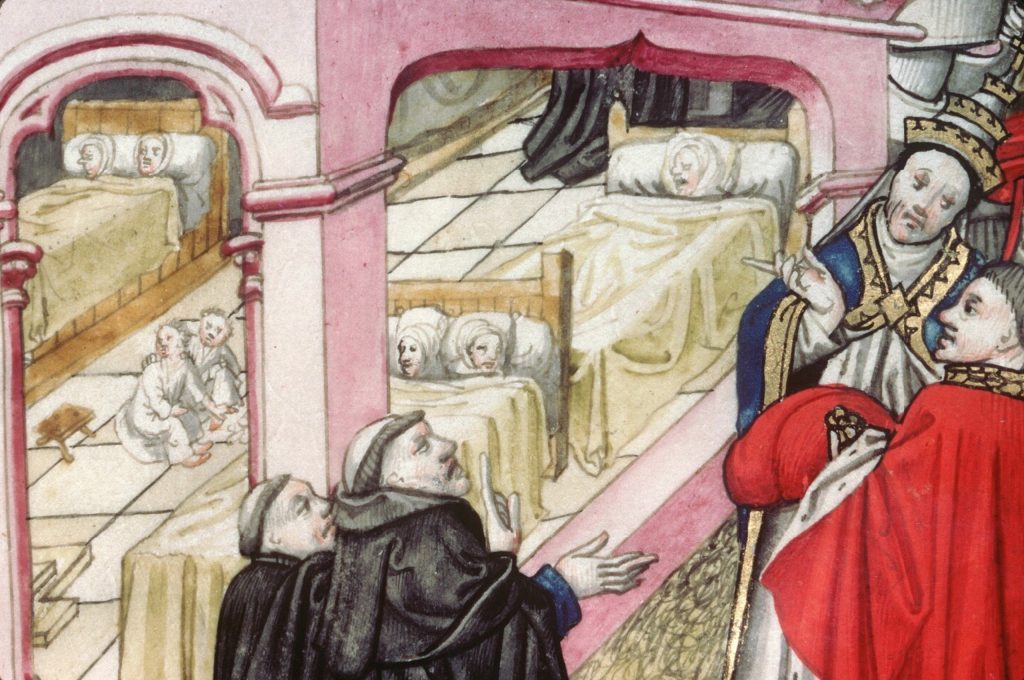
Figure 17. Dijon, “The Pope and Duke Visit the Hospital of Sto. Spirito in Rome,” Dijon, Archives hospitalières, Ms. A H 4, fol. 20 (detail), 1450s. Photo: IRHT/CNRS. By courtesy of the Dijon Bourgogne University Hospital.
Then the duke establishes his hospital in Dijon, whose patients include abandoned toddlers and babies, now well cared for in clean clothes and well-equipped cradles, which, if turned upside down, seem to be usable as children’s beds (Fig. 18).

Figure 18. Dijon, “Odo III Delivers the Papal Bull to the Religious of the Brotherhood in Dijon,” Dijon, Archives hospitalières, Ms. A H 4, fol. 24 (detail), 1450s. Photo: IRHT/CNRS. By courtesy of the Dijon Bourgogne University Hospital.
The penultimate illumination shows Duke Philip the Good and Duchess Isabella of Portugal visiting the hospital at Dijon in 1450 (Fig. 19).
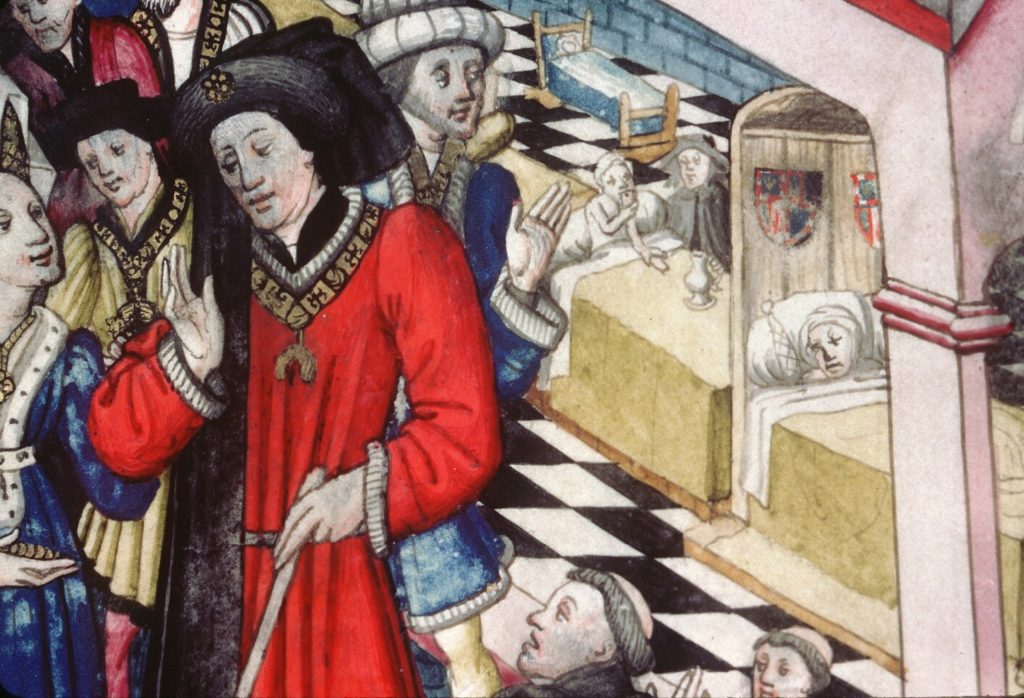
Figure 19. Dijon, “Visit of Philip the Good and Isabelle of Portugal to the Hospital of the Holy Spirit in Dijon,” Archives hospitalières, Ms. A H 4, fol. 25 (detail), 1450s. Photo: IRHT/CNRS. By courtesy of the Dijon Bourgogne University Hospital.
One child is visible among the patients. The final miniature depicts Pope Nicholas reconfirming the Order’s privileges.
Crapillet, the rector of the hospital, commissioned this pictorial narrative to reinforce the ties binding the duke and pope to the hospital in Dijon and to make clear its original independence from the hospital in Besançon.[80] But the illuminations also elucidate the hospital’s mission and for that reason visualize an alternative to infanticide: that the hospital can care for abandoned children. But what has happened to their mothers? Despite the fact that some hospitals cared for pregnant women before and after birth, as McDougall has shown, in this manuscript the mothers’ sole appearance is in the infanticide scene.[81] Only the babies are shown in subsequent illuminations since the function of these illuminations is to celebrate the hospital, which served only abandoned babies, not their parents. Unlike the young woman at Metz, who was forced to publicly fulfill the role of mother (if only symbolically and after her death), here women who abandon their children are excluded from their lives and become invisible. Although adopting different strategies, both the staged execution and the Burgundian illuminations contribute to the ideology of motherhood by reinforcing the negative view of a woman who does not want to mother. But only the Dijon manuscript suggests that mothers are not necessary to the well-being of their children.
But were mothers irrelevant? In fifteenth-century Leiden, the Masters of the Holy Spirit (Heilige Geestmeesters) cared for foundlings. Their archives still preserve a fascinating find: fifteenth-century name tags, which are collected in a contemporary booklet titled, “The Child Book: How the Children Came Here” (Item dat kijnderbock hoe dat die kijnder hier ghecomen sijen).[82] These tags, which were often pinned to the clothes of the abandoned child, sometimes simply give the name of the boy or girl: “This child is named Bartholomew” (Item Dit kint heeit bartelmeis), “Job is his name” (Job ist geheten), and “This child’s name is William” (Dit kint hiet Willem).[83] But others make clear that one or the other parent intended to retrieve the child when it became feasible. Those that were not written by a master of the orphanage, but rather by a less literate hand, probably a parent, sometimes indicate where the baby was left or other information that would enable the parent to reclaim the child at a later date. One, for example, reads, “My mother gave me an illegal father, which is why I was brought here as a foundling. Keep this note so that they can pick me up again later. I was baptized and born on St. Remigius day.”[84] But no mother is reunited with her child in the illuminations commissioned by the hospital administrator.
Conclusions
Northern European images of the fifteenth and sixteenth centuries reinforce and resist the ideology of motherhood. If most representations of infanticide support the idea that mothers will always love and protect their children, a few – based on classical myths as well as actual medieval events – betray the cracks in this ideology by representing murderous mothers. What visual images do not reveal is a place where mothers were supported so that they could raise their children without shame or ostracism, even if they were unwed or impoverished. Instead, northern European illuminations of idealized hospitals in Florence and Dijon show children well cared for, but without their mothers.
Hospitals could not solve the problem of infanticide, and attitudes towards mothers who killed their children hardened in the sixteenth century.[85] As illicit sex was dealt with more severely – brothels closed, homosexual acts more vigorously persecuted, rape victims increasingly maligned as seductresses – infanticide, which was at times associated with unwed mothers, came to be viewed in an ever more negative light. Whereas Gautier de Coinci’s Miracles de Nostre Dame showed the Virgin defending a child murderer, and up to the fifteenth century those who committed infanticide were sometimes pardoned in northern Europe, afterwards that practice became rare.[86] In 1556, Henri II proclaimed that “any infant death following a concealed pregnancy or clandestine childbirth, and with no formal baptism or burial, was presumed to be homicide and punishable by death.”[87] Similarly, although not one case of infanticide is mentioned in the English Coroner’s rolls dated 1265-1413, and many of those recorded in the fifteenth-century were pardoned, by 1624 concealment of a stillbirth by an unwed mother was punishable by death.[88]
Infanticide was inevitable in an age when many unwed mothers faced dire consequences, when abortion and birth control were unreliable, and when church and state offered few opportunities for either the pregnant woman or her abandoned child. The ideology of motherhood – the belief that women are naturally loving mothers who will protect their children at any cost – was insufficient in the Middle Ages to overcome these obstacles and children continued to die. Through safe, effective, and legal birth control and abortion infanticide has largely disappeared in the United States. But some politicians and Christian leaders today yearn for an imagined past when abortion was outlawed and birth control ineffective. Medieval infanticide, as constructed in both historical documents and visual imagery, makes clear that one possible outcome in such a world is the brutal murder of the unwanted child and the gruesome death of its mother. As income disparity grows, as laws place more and more obstacles in the way of obtaining a safe and legal abortion, as society fails to support pregnant women and unwanted children, some mothers may begin to feel once again that their best alternative is to turn to infanticide.
References
| ↑1 | For their assistance in the preparation of this article, I would like to thank Linda Austern, Diana Presciutti, Nancy Wicker, Joy Wiltenburg, and Sara McDougall. Kelley Vernon generously assisted in the preparation of the illustrations. I thank two anonymous readers for their thoughtful comments, and the editors of this volume, especially Jennifer Borland, Nancy Thompson, and Ginny Blanton for their careful reading, many invaluable suggestions, and encouragement. All translations are my own unless otherwise noted. |
|---|---|
| ↑2 | Sara McDougall, “Pardoning Infanticide in Late Medieval France,” Law & History Review (2021): 25. https://doi.org/10.1017/S0738248020000267 |
| ↑3 | Jacobus de Voragine, The Golden Legend. Readings on the Saints, trans. by William Granger Ryan (Princeton: Princeton University Press, 1993), vol. 1, pp. 56-59. |
| ↑4 | See panel paintings by Master Bertram, Joos van Cleve, Cornelis van Harlem, and Pieter Bruegel, among others. For a fifteenth-century relief, see the Retable du Rosaire (Chapelle Notre-Dame-des-Cieux), Brittany. For woodcuts, see Walter L. Strauss and Carol Schuler, The Illustrated Bartsch. German Book Illustration before 1500 (New York: Abaris Books, 1982), vol. 83, Part 4, p. 377, no. 1482/264; vol. 85, p. 125, no. 1485/202; vol. 86, p. 217. no. 1488/571. For the iconography of this theme, see Gertrud Schiller, Iconography of Christian Art, trans. by Janet Seligman (Greenwich, CT: New York Graphic Society, 1969) vol. 1, pp. 114-17. |
| ↑5 | Roger S. Wieck, Time Sanctified: The Book of Hours in Medieval Art and Life (New York: George Braziller and Baltimore: Walters Art Museum, 1988), especially pp. 60, 65. |
| ↑6 | For Jeremiah’s prophecy, referred to in Matthew 2:17-18, see Laura Jacobus, “Motherhood and Massacre: The Massacre of the Innocents in Late-Medieval Art and Drama,” in The Massacre in History, ed. by Mark Levene and Penny Roberts (New York and Oxford: Berghahn Books, 1999), p. 39. Brueghel’s painting is in the King’s Closet, Windsor Castle, RCIN 405787. |
| ↑7 | Jacobus, “Motherhood and Massacre,” p. 43. |
| ↑8 | The Psalter is that of St. Louis and Blanche of Castille, Paris, Arsenal, Ms. 1186, fol. 19v, ca. 1225. |
| ↑9 | Besides figs. 6-7, these include (1) Paris, Maitre François, Book of Hours, Oxford, Bodleian Library, Ms. Canon. Liturg. 43, fol. 220r; (2) Savoy, Hours of Louis of Savoy, Paris, Bib. nat., Ms. Latin 9473, fol. 58v, 1445-60; (3) Paris, Book of Hours, New York, Morgan Library & Museum, M.453, fol. 83v, ca. 1425-1430; (4) Paris, Master of the Munich Golden Legend, Book of Hours, Baltimore, Walters Art Museum, Ms. 288, fol. 73v. ca. 1425-30; (5) Rouen, Book of Hours, New York, The Morgan Library & Museum, Ms. M.646, fol. 51v, ca. 1510; (6) Langres, Book of Hours, New York, The Morgan Library & Museum, M.271, fol. 48r, 1495-1500; and (7) Paris (?), Book of Hours, The Hague, Koninklijke Bibliotheek, Ms. 76 F 14, fol. 47r, ca. 1490-1500. |
| ↑10 | Flemish (Ghent or Bruges), “Pilgrims Kneeling in a Church Portal and the Massacre of the Innocents,” in a Book of Hours-Missal, Cambridge, Harvard University, Houghton Library, MS Typ 443, fol. 166. |
| ↑11 | Stephen H. Goddard, The Master of Frankfurt and his Shop (Brussels: Paleis der Academiën, 1984). p. 148, cat. no. 69, fig. 7. |
| ↑12 | See Philippe de Vigneulles, La chronique de Philippe de Vigneulles, ed. by Charles Bruneau (Metz: Société d’histoire de d’archéologie de la Lorraine, 1927-33), III, pp. 337-38; Philippe de Vigneulles, Gedenkbuch der Metzer Bürgers Phlippe von Vigneulles aus den Jahren 1471 bis 1522 nach der Handschrift des Verfassers, ed. by Heinrich Michelant (Stuttgart: Litterarischen Vereins, 1852), p. 124. |
| ↑13 | For the original language, see Philippe de Vigneulles, La chronique, III, p. 338: “Et, tout premièrement, olt l’une des mains couppées; et puis on bouttait le feu, et fut arse et brûllée: non pas que l’on la lassait consumer; car, incontinant qu’elle fût morte, on estindait le feu, et demourait toutte droitte, qui estoit hideuse chose à veoir. Et lui mist on ung affans de boix entre ces bras, avec ung aultres en pointure.” For a slightly different translation, see Jody Enders, “Theater Makes History: Ritual Murder by Proxy in the Mistere de la Sainte Hostie,” Speculum 79 (2004): 1001. https://doi.org/10.1017/S0038713400086619 |
| ↑14 | Esther Cohen, “‘To Die a Criminal for the Public Good’: The Execution Ritual in Late Medieval Paris,” in Law, Custom, and the Social Fabric in Medieval Europe (Kalamazoo: Western Michigan University, 1990), p. 298. |
| ↑15 | The sculpture probably showed a swaddled infant. Although some such statues should be identified as the Christ Child since they show the blessing gesture, orb, or symbols of the Passion, others, which lack these signs, represent abandoned babies, and were displayed at Foundling Hospitals, such as one at Florence, and in illuminations of newborns exposed to the elements. See, for example, reliefs on the Hospital of Innocents in Florence; Frank Matthias Kammel, “Das Christkind in der eignen Stube: Private Bilder zum Weihnachtsfest im Spätmittelalter und heute,” in Im Zeichen des Christkinds: Privates Bild und Frömmigkeit im Spätmittelalter, ed. by Frank Matthias Kammel (Nuremberg: Germanisches Nationalmuseum, 2003), p. 40, Abb. 4; and the exposed child in the fourteenth-century encyclopedia Omne bonum, London, British Library, Royal 6E VII, fol. 104, which is illustrated in John Boswell, The Kindness of Strangers: The Abandonment of Children in Western Europe from Late Antiquity to the Renaissance (Chicago: The University of Chicago Press, 1988), figs. 13-14. |
| ↑16 | For the original language, see Philippe de Vigneulles, Gedenkbuch p. 124: “elle fut morte on estaindait le feu et fut mis son coprs sus une rue; et luy mist-on empres d’elle ung petit enffant de bois; et avoir encor avec cela ung aultre grant paipier, atachié à la dite rue, auquel avoit ung enffant en pointure et sa mère qui le tuoit.” I would like to thank Thelma Fenster, Sara McDougall, and Maurice Wolfthal for their advice translating the word “rue.” |
| ↑17 | See, among others, Wolfgang Schild, “Das Strafrecht als Phänomen der Geistesgeschiche,” in Justiz in alter Zeit, ed. by Christoph Hinckeldey (Rothenburg o.d.T: Mittelalterliches Kriminalmuseum, 1984), p. 23 (a print of 1589). |
| ↑18 | Quintilian, The Institutio Oratoria, trans. by H. E. Butler (London: William Heinemann and New York: G. P. Putnam’s Sons, 1921), vol. 2, pp. 402-03 (Quint. 6.2.23). The original language, on p. 402, reads: “depictam ira tabula sipariove imaginem rei, cuius atrocitate iudex erat commovendus.” |
| ↑19 | Samuel Y. Edgerton, Jr., Pictures and Punishment: Art and Criminal Prosecution During the Florentine Renaissance (Ithaca and London: Cornell University Press, 1985), pp. 65-66. |
| ↑20 | Ulinka Rublack, The Crimes of Women in Early Modern Germany (Oxford: Clarendon Press, 1999), p. 165. |
| ↑21 | For the original language, see Alexandre Samouillan, Olivier Maillard, sa prédication et son temps (Toulouse: Edward Privat and Paris: Ernest Thorin, 1891), p. 316: “du fond des latrines, des étangs et des fleuves, les gemissements des enfants qu’on y aivait jetés.” See also Y.-B. Brissaud, “L’infanticide à la fin du moyen age, ses motivations psychologiques et sa répression,” Revue historique de droit français et étranger sér. 4, vol. 50.2 (1972), p. 232. |
| ↑22 | For these laws, see Michael Obladen, “From Sin to Crime: Laws on Infanticide in the Middle Ages, Neonatology 109.3 (2016): 85-90. https://doi.org/10.1159/000440876 |
| ↑23 | For the identity of baby killers, see Pablo Fernandez, “Het Verschijnsel Kindermoord in de Nederlanden (XIVde-XVde eeuw),” in Sociale structuren en topografie van armoede in rijkdom in de 14e en 15e eeuw. Methodologische aspecten en resultaten van recent onderzoek. Studia Historica Gandensia 267 (Ghent: FKFO, 1986), pp. 118-23; Sara M. Butler, “A Case of Indifference?: Child Murder in Later Medieval England,” Journal of Women’s History 19.4 (2007): 59-82; Aleksandra Pfau, Medieval Communities and the Mad: Narratives of Crime and Mental Illness in Late Medieval France (Amsterdam, Amsterdam University Press, 2020), pp. 102-04; Sara McDougall, “Pardoning Infanticide,” 1-25. For the debate about whether the typical profile of the late medieval offender is a poor, unwed woman, see William L. Langer, “Infanticide: A Historical Survey,” History of Childhood Quarterly 1 (1973-74): 353-65; Peter C. Hoffer and N. E. H. Hull, Murdering Mothers (New York: New York University Press, 1981), pp. 95, 98, 100; Fernandez, “Kindermoord,” pp. 118-23; R. H. Helmholz, Canon Law and the Law of England (London: Hambledon, 1987), p. 166; Natalie Zemon Davis, Fiction in the Archives: Pardon Tales and their Tellers in Sixteenth-Century France (Stanford: Stanford University Press, 1987), p. 85; Myriam Greilsammer, Mariage et maternité médiévale (Paris: Armand Colin, 1990), p. 304; J. A. Sharpe, Crime in Early Modern England 1550-1750 (London: Longman, 1994), p. 110; Rublack, Crimes of Women, p. 162; and Sara McDougall, “Singlewomen and Illicit Pregnancy in Late Medieval France: The Case of Marie Ribou (1481),” French Historical Studies 44.3 (Aug. 2021): 529-58. |
| ↑24 | Keith Wrightson, “Infanticide in European History,” Criminal Justice History 3 (1982): 5; Josiah Cox Russell, British Medieval Population (Albuquerque: University of New Mexico, 1948), p. 168; Christiane Klapisch, “L’enfance en Toscane au début du XVème siècle,” Annales de démographie historique (1973), p. 109; Fernandez, “Kindermoord,” p. 123, note 73 for additional sources; and Katherine A. Lynch, “Why weren’t (many ) European women ‘missing’?” The History of the Family 16:3 (2011): 250-66. |
| ↑25 | For infanticide by suffocation, see Helmholz, Canon Law, p. 160; Butler, “A Case of Indifference,” p. 63. On p. 70, Butler suggests that breaking the infant’s neck was also very common. |
| ↑26 | Barbara A. Kellum, “Infanticide in England in the Later Middle Ages,” History of Childhood Quarterly 1 (1973-74): 367. For Jean Gerson on this issue, see Claude Gauvard and Gilbert Ouy, “Gerson et l’infanticide: Défense des femmes et critique de la pénitence publique” (London, British Library, Add. Ms. 29279, fols. 19v-20v), in ‘Riens ne m’est seur que la chose incertaine’: Études sur l’art d’écrire au Moyen Âge offertes à Eric Hicks par ses élèves, collègues, amies et amis, ed. by Jean-Claude Mühlethaler and Denis Billottee (Geneva: Slatkine, 2001), pp. 51-52. |
| ↑27 | De Vigneulles, “Gedenkbuch,” p. 124. |
| ↑28 | Martin Luther, Luther on Women: A Sourcebook, trans. and ed. by Susan C. Karant-Nunn and Merry E. Wiesner-Hanks (Cambridge: Cambridge University Press, 2003), p. 182. |
| ↑29 | For Simon of Trent, see Jeanette Kohl, “A Murder, a Mummy, and a Bust: The Newly Discovered Portrait of Simon of Trent at the Getty,” Getty Research Journal 10 (2018): 37-60. For Erhard Schon’s Turkish Atrocities during the Siege of Vienna, 1529, see Diane Wolfthal, Images of Rape: The ‘Heroic’ Tradition and Its Alternatives (Cambridge: Cambridge University Press, 1999), p. 79, fig. 43. See also a Parisian illumination, “Third Crusade of Pastoureaux; Jews throwing their children from a tower,” in Chroniques de France ou de St. Denis, London, British Library, Ms. Royal 20 C VII f. 55v, after 1380. https://doi.org/10.1086/697383 |
| ↑30 | For example, see Parisian illuminator, “Amazons kill their sons and mutilate their daughters,” in Vincent Beauvais, Speculum historiale, trans. by Jean de Vignay, Paris, Bibl. nat., Ms. fr. 50, fol. 40v, 1463; Bourges artist,”Amazons,” in Secrets de l’histoire naturelle, Paris, Bib. Nat., Ms. fr. 1377, fol. 2v, ca. 1428. |
| ↑31 | For the original language and its translation, see Hannah Morcos and Henry Ravenhall, “Feminine fury or motherly love? The Cimbrian women in the Histoire ancienne jusqu’à César” (accessed 10/8/21). See, for example, Morgan Library, Ms. M. 381, fol. 46r. |
| ↑32 | Giovanni Boccaccio, Concerning Famous Women, trans. and ed. by Guido A. Guarino (New Brunswick: Rutgers University Press, 1963), p. 177. For the original Latin, see Morcos and Ravenhall, “Feminine Fury.” |
| ↑33 | Boccaccio, p. 177. |
| ↑34 | “The wives of the Cimbrians kill their children and hang themselves,” in Giovanni Boccaccio, Des cleres et nobles femmes, Paris, Bib. nat., Ms. fr. 12420, fol. 120v. For this manuscript, see Brigitte Buettner, Boccaccio’s “Des cleres et nobles femmes”: Systems of Signification in an Illuminated Manuscript (Seattle and London: University of Washington Press, 1996). For the illumination, see Ibid., pp. 40-41, 68. 69. A similar composition appears in another Boccaccio manuscript, London, British Library, Royal 16 G V, f. 94v. |
| ↑35 | See The Illustrated Bartsch, ed. by Walter L. Strauss, vol. 82, p. 199, fig. 1479/119, for “The Cimbrians,” in Giovanni Boccaccio, Von etlichen Frowen (Augsburg: Anton Sorg, 1479), fol. 107r. |
| ↑36 | “The Cimbrians” in Giovanni Boccaccio, De claris mulieribus (Bern: Mathias Apiarus, 1539) illustrated in Boccaccio, Concerning Famous Women, p. 176. |
| ↑37 | Pfau, Medieval Communities and the Mad, pp. 64, 160. |
| ↑38 | Pfau, Medieval Communities and the Mad, p. 103 (her translation): “par sa simplesse et ignorance et la povrete et misere enquoy elle estoit.” |
| ↑39 | Pfau, Medieval Communities and the Mad, p. 103. |
| ↑40 | Pfau, Medieval Communities and the Mad, pp. 201-03. |
| ↑41 | Cologny, Fondation Martin Bodmer, Cod. Bodmer 160, fol. 74 reads, in part, “elle estrangla les desu enf ās.” For this manuscript, see https://www.e-codices.unifr.ch/en/list/one/fmb/cb-0160 (accessed 12/31/2020). |
| ↑42 | The original language reads, “Comme medee par desplessir du departemet de Jazon morut dolereusement foursence et estranit ses deus enfans quelle avoit eu de Jazon.” |
| ↑43 | For the curtain sack as womb, see Susan Koslow, “The Curtain-Sack: A Newly Discovered Incarnation Motif in Rogier van der Weyden’s Columba Annunciation” artibus et historiae, nr. 13, 1986, 9-34. https://doi.org/10.2307/1483245 |
| ↑44 | Morcos and Ravenhall, “Feminine Fury.” |
| ↑45 | This section builds on my Images of Rape, ch. 5. See also Marilynn Desmond and Pamela Sheingorn, Myth, Montage, & Visuality in Late Medieval Manuscript Culture: Christine de Pizan’s “Epistre Othea” (Ann Arbor: University of Michigan Press, 2003) and Sandra Hindman, Christine de Pizan’s “Epistre Othéa”: Painting and Politics at the Court of Charles VI (Toronto: Pontifical Institute of Mediaeval Studies, 1986). |
| ↑46 | See Desmond and Sheingorn, Myth, Montage, & Visuality, p. 10, for translation and original language: “avorter/ A fol delit.” |
| ↑47 | Ibid., p. 10, for original language and translation. |
| ↑48 | Hindman, Christine de Pizan’s “Epistre Othéa,” p. 96 |
| ↑49 | For this illumination, see Sylvie Laurent, Naître au Moyen Age. De la conception à la naissance: La grossesse et l’accouchement (XII e-XVe siècle) (Paris: Le Léopard d’Or, 1989), caption for fig. 17; Diana Bullen Presciutti, “Dead Infants, Cruel Mothers, and Heroic Popes: The Visual Rhetoric of Foundling Care at the Hospital of Santo Spirito, Rome,” Renaissance Quarterly 64.3 (Fall 2011), p. 771-72; Yolanta Zaluska, Manuscrits enluminés de Dijon (Paris: Éditions du Centre National de la Recherce Scientifique, 1991), p. 248. For general bibliography on the manuscript, see, among others, Yolanta Zaluska, “Pierre Crapillet et l’Histoire en images de l’Hôpital du Saint-Esprit de Dijon,” Revue de l’Art 84 (1989): 44-47; Zaluska, Manuscrits, pp. 247-50; R. Bultot, “Pierre Crapillet, Philippe le Bon et le manuscrit à peinture A4 de l’Hôpital du Saint-Esprit de Dijon: Remarques de méthode à propos d’une étude récente,” Le Moyen Âge 102.2 (1996): 245-87. |
| ↑50 | See below for caption and its translation. |
| ↑51 | Observed by Inge Walter, “Die Sage der Gründungvon Santo Spirito in Rom und das Problem des Kindesmordes,” in Mélanges de l’École française de Rome. Moyen-Age, Temps modernes 97 (1985): 826. https://doi.org/10.3406/mefr.1985.2826 |
| ↑52 | The original language reads: “Cōment les doloreuses pecheresses apres leur enfantement, cuidant eviter la honte du monde sans penser en dieu ne [inserted above as correction] en leurs ames, par la monetement des dyables, getoiēt leurs enfans sans baptisme en la riviere du tymbre a rome.” See also Zaluska, Manuscrits, p. 348, who transcribes the caption inaccurately and, for a slightly different translation, Boswell, Kindness of Strangers, fig. 15. |
| ↑53 | Recently Sara McDougall argued that we should radically revise our thinking about women who kill their infants and she cautions readers to “shake off the reflexive assumption that infanticidal single mothers must have been especially reviled.” Still, where McDougall sees Christian mercy and redemption as driving ideologies in the presentation of infanticide as presented in legal contexts, I contend that other material artifacts, especially the multivalent images I discuss here, continue to drive the narrative of the violent mother as unnatural. For McDougall’s scholarship, see “Pardoning Infanticide,” (quote on p. 13), and “Singlewomen and Illicit Pregnancy.” |
| ↑54 | Davis, Fiction in the Archives, p. 85, Brissaud, “L’infanticide,” p. 239: “comme toute déspespérée craignant le vitupère du monde et le blasme de sesdiz anis….prins ledit enfant qui estoit en vie et l’eust lié de ses gerretieres par la gorge et l’eust bouté ou feurre de son lit et estoupé la bouche et couchée dessus tant qu’il fu estaint.” |
| ↑55 | Wrightson, “Infanticide in European History,” p. 7. |
| ↑56 | Greilsammer, Mariage et maternité médiévale, p. 307: “… doubtant le corroux et estre en l’indignacion dudit seigneur de Lichtervelde son oncle, et temptée de l’ennemy …” For this case, see also Peter Arnade and Walter Prevenier, Honor, Vengeance, and Social Trouble: Pardon Letters in the Burgundian Low Countries (Ithaca and London: Cornell University Press, 2015, pp. 108-10. |
| ↑57 | Grielsammer, Mariage et maternité, p. 307: “la grands paour qu’elle avoit de son fait feust sceu.” |
| ↑58 | Brissaud, “L’infanticide,” p. 233: “mon amy, se j’estois grosse, que ferray-je? je seray deshonnorée.” |
| ↑59 | Ibid.: “graignant la honte et vergoinge du monde.” |
| ↑60 | Davis, Fiction in the Archives, p. 85 |
| ↑61 | See note 53. |
| ↑62 | Ibid., p. 6. |
| ↑63 | Neil Cartlidge, “‘Alas, I go with chylde’: Representations of Extra-Marital Pregnancy in the Middle English Lyric,” English Studies 5 (1998): 400 for the text, for the translation see n. 16. https://doi.org/10.1080/00138389808599143 |
| ↑64 | Linda Austern, “Women’s Musical Voices in Sixteenth-Century England,” Early Modern Women: An Interdisciplinary Journal 3 (2008): 134-35; Cartlidge, “‘Alas, I go with chylde’,” p. 400. https://doi.org/10.1086/EMW23541522 |
| ↑65 | The song appears in London, British Library, Add. MS 5665. For it see John Stevens, Music & Poetry in the Early Tudor Court (Lincoln, NE: University of Nebraska Press, 1961) and more recently in Austern, “Women’s Musical Voices in Sixteenth-Century England,” pp. 134-35 (quote on p. 129). |
| ↑66 | For this woodcut, see Joy Wiltenburg, Disorderly Women and Female Power (Charlottesville and London: University Press of Virginia, 1992), pp. 227-29. For the text, see also Joy Wiltenburg, “True Crime: The Origins of Modern Sensationalism,” The American Historical Review 109(5): 1386-1387. |
| ↑67 | Wiltenburg, Disorderly Women and Female Power, p. 228. |
| ↑68 | Wiltenburg, Disorderly Women and Female Power, p. 228. |
| ↑69 | See The Hague, Koninklijke Bibliotheek, Ms. 71 A 24, fol. 165r. |
| ↑70 | Ferguson, “Kindermoord,” p. 122. |
| ↑71 | Peggy McCracken, “Engendering Sacrifice: Blood, Lineage, and Infanticide in Old French Literature,” Speculum 77.1 (Jan. 2002): 55. https://doi.org/10.2307/2903786 |
| ↑72 | Davis, Fiction in the Archives, p. 79. |
| ↑73 | For this series, see Kathleen Wilson-Chevalier, “Sebastian Brant: The Key to Understanding Luca Penni’s Justice and the Seven Deadly Sins,” The Art Bulletin 78.2 (June 1996): 236-63. https://doi.org/10.2307/3046174 |
| ↑74 | Wilson-Chevalier, “Sebastian Brant,” p. 251. Illuminations include Los Angeles, J. Paul Getty Museum, Giovanni Boccaccio, Des cas des nobles hommes et femmes, Ms. 63, fol. 241, ca. 1413-15; Josephus Flavius, Antiquités judaïques, Paris, BnF Ms. fr. 13, fol. 266, 1475-1500; and Vincent Beauvais, Speculum historiale, trans. by Jean de Vignay, Paris, Bibl. nat., Ms. fr. 50, fol. 355, 1463. |
| ↑75 | For witches as cannibals, see Charles Zika, Exorcising Our Demons: Magic, Witchcraft and Visual Culture in Early Modern Europe (Leiden: Brill, 2003), pp. 445-73. For witches as child-murderers, see Charles Zika, The Appearance of Witchcraft: Print and Visual Culture in Sixteenth-Century Europe (London and New York: Routledge, 2007), pp. 126, 231. According to the Malleus Maleficarum, midwives were witches who killed and ate unbaptized children. See Hans Peter Broedel, The Malleus Maleficarum and the Construction of Witchcraft: Theology and Popular Belief (Manchester: Manchester University Press, 2003), p. 30. For other types of child murdering witches, those who appear as cats and old women, for example, see also pp. 45, 104-09, 124-29, 135. For Famine, see Etienne Delaune, Famine, from a series of four Allegorical engravings dated 1575. |
| ↑76 | On the history of the hospitals, see, among others, Lester, “Lost but not yet Found,” and Diana Bullen Presciutto, “Dead Infants, Cruel Mothers, and Heroic Popes: The Visual Rhetoric of Foundling Care at the Hospital of Santo Spirito, Rome,” Renaissance Quarterly 64.3 (Fall 2011): 752-99. https://doi.org/10.1086/662849 |
| ↑77 | In its deed of foundation, dated May 1215, the word hospital is not mentioned. Instead, it is said to be established for “God, the brothers, and the poor.” See Gisela Drossbach, “Christliche caritas als Rechtinstitut. Hospital und Orden von Santo Spirito in Sassia (1198-1378) (Paderborn et al.: Ferdinand Schöningh, 2005), p. 205. |
| ↑78 | The original language of the caption reads: “ Cōment les pescheurs et seruiteurs du pape peschoient en la Riuiere du tymbre, et ne prindrent que petis enfans que on auoit gettez en la ditte riuiere, dont ilz furent moult esbahis en disant quilz nauoyent peu prendre aultre poisson.” |
| ↑79 | The original language reads: “…pour recepuoir tous poures, et pour nourrir tous petis enffans getez.” |
| ↑80 | Bultot, “Pierre Crapillet.” |
| ↑81 | McDougall, “Singlewomen and Illicit Pregnancy.” |
| ↑82 | For the Foundling Hospital in Leiden, see Kees van der Wiel, Der kint hiet Willem. Der Heilige Geest in Leiden – 700 jaar vondelingen, wezen en jeugdzorg (Leiden: Primavera Pers, 2010). For the name tags, Erik Kwaakkel, “Rare Medieval Name Tags,” posted April 24, 2015, HTTPS://MEDIEVALBOOKS.NL/2015/04/24/RARE-MEDIEVAL-NAME-TAGS, accessed Jan. 25. 2021 |
| ↑83 | See Ibid for transcription and translation. |
| ↑84 | See Ibid for original language and translation: “Mijn moeder min een onrecht vader gaf daer om ben ic voer een vondelinck gebracht, bewaert dit briefken v[…] opdat nae min weder halen sal ic ben gedopt ende op Remigius dach geboren.” |
| ↑85 | Wrightson, “Infanticide in European History,” p. 5. |
| ↑86 | Davis, Fiction in the Archives, p. 86. |
| ↑87 | Ibid.; Julie Hardwick, Sex in an Old Regime City: Young Workers and Intimacy in France, 1600-1789 (Oxford University Press, 2000), pp. 25-26. |
| ↑88 | Kellum, “Infanticide in England,” p. 371-73; J. A. Sharpe, Crime in Early Modern England: 1550-1750 (London: Longman, 1984), p. 61. |
